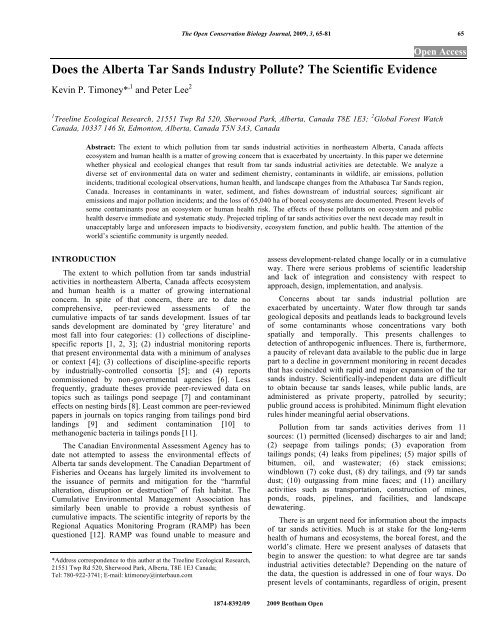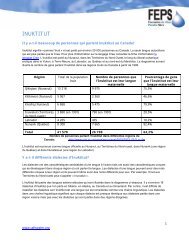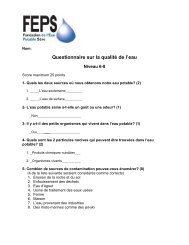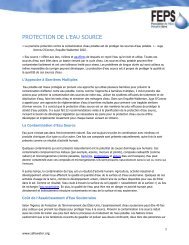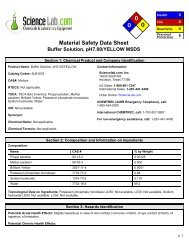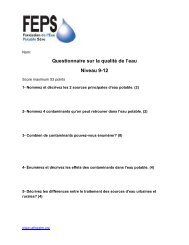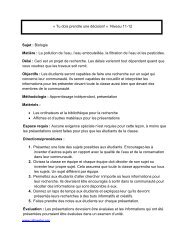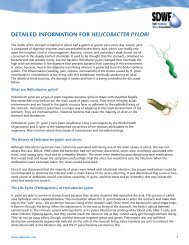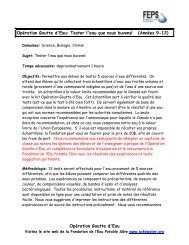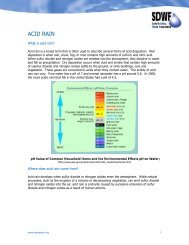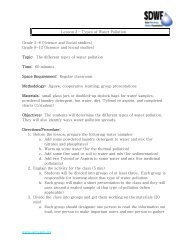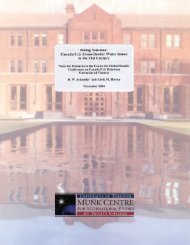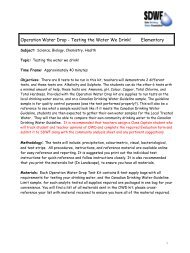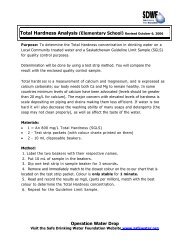Does the Alberta Tar Sands Industry Pollute? - Centre for Aboriginal ...
Does the Alberta Tar Sands Industry Pollute? - Centre for Aboriginal ...
Does the Alberta Tar Sands Industry Pollute? - Centre for Aboriginal ...
Create successful ePaper yourself
Turn your PDF publications into a flip-book with our unique Google optimized e-Paper software.
The Open Conservation Biology Journal, 2009, 3, 65-81 65<br />
<strong>Does</strong> <strong>the</strong> <strong>Alberta</strong> <strong>Tar</strong> <strong>Sands</strong> <strong>Industry</strong> <strong>Pollute</strong>? The Scientific Evidence<br />
Kevin P. Timoney* ,1 and Peter Lee 2<br />
Open Access<br />
1 Treeline Ecological Research, 21551 Twp Rd 520, Sherwood Park, <strong>Alberta</strong>, Canada T8E 1E3; 2 Global Forest Watch<br />
Canada, 10337 146 St, Edmonton, <strong>Alberta</strong>, Canada T5N 3A3, Canada<br />
Abstract: The extent to which pollution from tar sands industrial activities in nor<strong>the</strong>astern <strong>Alberta</strong>, Canada affects<br />
ecosystem and human health is a matter of growing concern that is exacerbated by uncertainty. In this paper we determine<br />
whe<strong>the</strong>r physical and ecological changes that result from tar sands industrial activities are detectable. We analyze a<br />
diverse set of environmental data on water and sediment chemistry, contaminants in wildlife, air emissions, pollution<br />
incidents, traditional ecological observations, human health, and landscape changes from <strong>the</strong> Athabasca <strong>Tar</strong> <strong>Sands</strong> region,<br />
Canada. Increases in contaminants in water, sediment, and fishes downstream of industrial sources; significant air<br />
emissions and major pollution incidents; and <strong>the</strong> loss of 65,040 ha of boreal ecosystems are documented. Present levels of<br />
some contaminants pose an ecosystem or human health risk. The effects of <strong>the</strong>se pollutants on ecosystem and public<br />
health deserve immediate and systematic study. Projected tripling of tar sands activities over <strong>the</strong> next decade may result in<br />
unacceptably large and un<strong>for</strong>eseen impacts to biodiversity, ecosystem function, and public health. The attention of <strong>the</strong><br />
world’s scientific community is urgently needed.<br />
INTRODUCTION<br />
The extent to which pollution from tar sands industrial<br />
activities in nor<strong>the</strong>astern <strong>Alberta</strong>, Canada affects ecosystem<br />
and human health is a matter of growing international<br />
concern. In spite of that concern, <strong>the</strong>re are to date no<br />
comprehensive, peer-reviewed assessments of <strong>the</strong><br />
cumulative impacts of tar sands development. Issues of tar<br />
sands development are dominated by ‘grey literature’ and<br />
most fall into four categories: (1) collections of disciplinespecific<br />
reports [1, 2, 3]; (2) industrial monitoring reports<br />
that present environmental data with a minimum of analyses<br />
or context [4]; (3) collections of discipline-specific reports<br />
by industrially-controlled consortia [5]; and (4) reports<br />
commissioned by non-governmental agencies [6]. Less<br />
frequently, graduate <strong>the</strong>ses provide peer-reviewed data on<br />
topics such as tailings pond seepage [7] and contaminant<br />
effects on nesting birds [8]. Least common are peer-reviewed<br />
papers in journals on topics ranging from tailings pond bird<br />
landings [9] and sediment contamination [10] to<br />
methanogenic bacteria in tailings ponds [11].<br />
The Canadian Environmental Assessment Agency has to<br />
date not attempted to assess <strong>the</strong> environmental effects of<br />
<strong>Alberta</strong> tar sands development. The Canadian Department of<br />
Fisheries and Oceans has largely limited its involvement to<br />
<strong>the</strong> issuance of permits and mitigation <strong>for</strong> <strong>the</strong> “harmful<br />
alteration, disruption or destruction” of fish habitat. The<br />
Cumulative Environmental Management Association has<br />
similarly been unable to provide a robust syn<strong>the</strong>sis of<br />
cumulative impacts. The scientific integrity of reports by <strong>the</strong><br />
Regional Aquatics Monitoring Program (RAMP) has been<br />
questioned [12]. RAMP was found unable to measure and<br />
*Address correspondence to this author at <strong>the</strong> Treeline Ecological Research,<br />
21551 Twp Rd 520, Sherwood Park, <strong>Alberta</strong>, T8E 1E3 Canada;<br />
Tel: 780-922-3741; E-mail: ktimoney@interbaun.com<br />
assess development-related change locally or in a cumulative<br />
way. There were serious problems of scientific leadership<br />
and lack of integration and consistency with respect to<br />
approach, design, implementation, and analysis.<br />
Concerns about tar sands industrial pollution are<br />
exacerbated by uncertainty. Water flow through tar sands<br />
geological deposits and peatlands leads to background levels<br />
of some contaminants whose concentrations vary both<br />
spatially and temporally. This presents challenges to<br />
detection of anthropogenic influences. There is, fur<strong>the</strong>rmore,<br />
a paucity of relevant data available to <strong>the</strong> public due in large<br />
part to a decline in government monitoring in recent decades<br />
that has coincided with rapid and major expansion of <strong>the</strong> tar<br />
sands industry. Scientifically-independent data are difficult<br />
to obtain because tar sands leases, while public lands, are<br />
administered as private property, patrolled by security;<br />
public ground access is prohibited. Minimum flight elevation<br />
rules hinder meaningful aerial observations.<br />
Pollution from tar sands activities derives from 11<br />
sources: (1) permitted (licensed) discharges to air and land;<br />
(2) seepage from tailings ponds; (3) evaporation from<br />
tailings ponds; (4) leaks from pipelines; (5) major spills of<br />
bitumen, oil, and wastewater; (6) stack emissions;<br />
windblown (7) coke dust, (8) dry tailings, and (9) tar sands<br />
dust; (10) outgassing from mine faces; and (11) ancillary<br />
activities such as transportation, construction of mines,<br />
ponds, roads, pipelines, and facilities, and landscape<br />
dewatering.<br />
There is an urgent need <strong>for</strong> in<strong>for</strong>mation about <strong>the</strong> impacts<br />
of tar sands activities. Much is at stake <strong>for</strong> <strong>the</strong> long-term<br />
health of humans and ecosystems, <strong>the</strong> boreal <strong>for</strong>est, and <strong>the</strong><br />
world’s climate. Here we present analyses of datasets that<br />
begin to answer <strong>the</strong> question: to what degree are tar sands<br />
industrial activities detectable? Depending on <strong>the</strong> nature of<br />
<strong>the</strong> data, <strong>the</strong> question is addressed in one of four ways. Do<br />
present levels of contaminants, regardless of origin, present<br />
1874-8392/09 2009 Bentham Open
66 The Open Conservation Biology Journal, 2009, Volume 3 Timoney and Lee<br />
an ecosystem or human health concern? Holding time<br />
constant, is <strong>the</strong>re evidence of increased levels of<br />
contaminants when sites downstream of industry are<br />
compared to sites upstream of industry? Holding sites<br />
constant, is <strong>the</strong>re evidence of increased levels of<br />
contaminants over time? Are <strong>the</strong>re documented incidents of<br />
industrial pollution?<br />
METHODS<br />
Study Area<br />
The study area is located in nor<strong>the</strong>astern <strong>Alberta</strong>’s Boreal<br />
Forest Natural Region, primarily within its central<br />
mixedwood sub-region [13]. The area currently undergoing<br />
surface mining straddles <strong>the</strong> Athabasca River and extends<br />
from roughly Ft. McMurray north to <strong>the</strong> Firebag River (Fig.<br />
1). There <strong>the</strong> dominant vegetation is a mosaic of white<br />
spruce (Picea glauca) and aspen (Populus tremuloides)<br />
<strong>for</strong>ests on fine-textured Gray Luvisolic upland soils; jack<br />
pine (Pinus banksiana) <strong>for</strong>ests on sandy Brunisolic uplands;<br />
riparian balsam poplar (Populus balsamifera) <strong>for</strong>ests and<br />
willow (Salix spp.) carrs on silty alluvial Regosols; and<br />
open, shrub willow, and treed (Picea glauca, P. mariana,<br />
and Larix laricina) fens and bogs on poorly-drained Organic<br />
Mesisols and Fibrisols. The Athabasca River, incised to a<br />
depth of about 60-70 m below <strong>the</strong> plain, is <strong>the</strong> dominant<br />
landscape feature of <strong>the</strong> area. Recent average discharge of<br />
<strong>the</strong> Athabasca River below Ft. McMurray is 503 m 3 /sec<br />
(2000-2007, Water Survey of Canada data). Ft. McMurray<br />
mean annual temperature is 0.1 C; annual precipitation is<br />
444 mm (Environment Canada data, Ft. McMurray airport, n<br />
= 60 and 59 years).<br />
To date, most development has focussed on extracting<br />
bitumen through surface mining of Cretaceous McMurray<br />
Formation deposits. Bitumen is a viscous mixture of<br />
hydrocarbons that contains about 83% carbon, 10%<br />
hydrogen, 5% sulphur, 1% oxygen, 0.4% nitrogen, and trace<br />
quantities of methane, hydrogen sulphide, and metals. The<br />
deposits are referred to as “tar sands” or “oil sands”,<br />
although <strong>the</strong> technically correct term is bitumen sands. By<br />
area, about 20% of <strong>the</strong> Athabasca deposits can be surface<br />
Fig. (1). Athabasca tar sands industrial footprint (hachured) as of March 2008. Inset shows <strong>the</strong> study area within <strong>the</strong> regional context;<br />
abbreviations: AB = <strong>Alberta</strong>, FM = Fort McMurray, NWT = Northwest Territories, PAD = Peace-Athabasca Delta and Fort Chipewyan, SK<br />
= Saskatchewan.
<strong>Alberta</strong> <strong>Tar</strong> <strong>Sands</strong> Pollution The Open Conservation Biology Journal, 2009, Volume 3 67<br />
mined. The remainder requires in situ well-based methods<br />
such as steam-assisted gravity drainage to recover bitumen in<br />
deposits lying too deep to surface mine.<br />
The Muskeg River [14] is a brown-water stream; calcium<br />
and bicarbonate are its major ions. Peatlands cover 50-90%<br />
of <strong>the</strong> area of some sub-basins and are <strong>the</strong> main source of <strong>the</strong><br />
river’s high levels of dissolved organic carbon. The river is<br />
somewhat alkaline and well-buffered; suspended solids and<br />
turbidity are low; dissolved oxygen is low during <strong>the</strong> period<br />
of ice cover. The majority of <strong>the</strong> river’s discharge appears to<br />
derive from shallow groundwater, much of which may flow<br />
through shallow organic soils at <strong>the</strong> peat/mineral interface.<br />
Discharges to <strong>the</strong> Muskeg River from tar sands activities in<br />
2006 were estimated at 2.53 billion L [5]. The proportion of<br />
this volume represented by tailings was not specified, but<br />
such a discharge represented about 3.6% of total flow of <strong>the</strong><br />
Muskeg River in 2006.<br />
Suncor’s <strong>Tar</strong> Island Pond One (tailings pond) and <strong>the</strong> <strong>Tar</strong><br />
Island Dyke (TID) separating it from <strong>the</strong> Athabasca River<br />
were <strong>the</strong> first such built in <strong>the</strong> industry. A tar sand tailings<br />
pond contains <strong>the</strong> residue or tails left after bitumen is<br />
extracted from <strong>the</strong> sand, which consists of process water,<br />
sand, fines (silts and clays), residual bitumen (1-5%), and<br />
associated chemicals. TID was constructed over <strong>the</strong> period<br />
1965 to 1980 to a height of ~91 m and a length of 3.5 km<br />
perched above <strong>the</strong> Athabasca River (Fig. 1). Sand tailings<br />
were placed hydraulically to build <strong>the</strong> dyke while fine<br />
tailings and process-affected water were discharged into <strong>the</strong><br />
pond [7]. A shallow layer of process water covers <strong>the</strong> pond<br />
which overlies fine tailings that become more consolidated<br />
with depth. Tailings process water, thin layers of<br />
consolidated fine tailings, and residual bitumen are found<br />
within <strong>the</strong> dyke [7]. The dyke is constructed on a weak<br />
foundation of alluvial clay and, in response to high thrust,<br />
has undergone a history of lateral creep [15]. The tailings<br />
pond covers ~ 145 ha, 1.2% of <strong>the</strong> total area of tailings<br />
ponds as of spring 2008.<br />
Analyses and Data Sources<br />
A Muskeg River polycyclic aromatic hydrocarbon (PAH)<br />
dataset was analyzed [raw data from 5]. Semipermeable<br />
membrane devices (SPMDs) were deployed at two sites in<br />
<strong>the</strong> Muskeg River during summer 2006 from 25 July to 27<br />
August. Site MUR-6 was located upstream of development;<br />
Site MUR-5 was located downstream of tar sands industrial<br />
development. Data were edited to avoid double-counting of<br />
some PAHs. Corrected PAH concentrations were <strong>the</strong><br />
observed values minus <strong>the</strong> corresponding trip blanks. For<br />
analytes in which <strong>the</strong> trip blank was greater than ei<strong>the</strong>r of <strong>the</strong><br />
observed values, corrected values were not calculated.<br />
Analytes that failed to meet quantification criteria were<br />
deleted. Day 0 and trip blanks were <strong>the</strong> mean of two values<br />
standardized to 4 SPMDs per sample. For sites MUR-5 and<br />
MUR-6, values are <strong>the</strong> mean of four SPMDs. The effect of<br />
upstream vs. downstream position was quantified in two<br />
ways: by <strong>the</strong> ratio of downstream (MUR-5) concentration to<br />
upstream (MUR-6) concentration, and by <strong>the</strong> difference<br />
between downstream and upstream concentration.<br />
A spreadsheet of RAMP sediment PAH concentrations<br />
from sites in <strong>the</strong> Athabasca River Delta was obtained<br />
courtesy of <strong>the</strong> Mikisew Cree First Nation. Values were<br />
calculated by summing <strong>the</strong> concentration of <strong>the</strong> individual<br />
alkylated PAH species. Concentrations of mercury in Lower<br />
Athabasca River walleye tissue were obtained in tabular<br />
<strong>for</strong>m from <strong>the</strong> literature. For both PAHs and mercury,<br />
statistics were calculated from <strong>the</strong> raw data.<br />
Data on <strong>the</strong> concentrations of 24 dissolved analytes from<br />
porewater in <strong>the</strong> sediment of <strong>the</strong> Athabasca River upstream<br />
and downstream of <strong>Tar</strong> Island Pond One provided a test of<br />
whe<strong>the</strong>r tailings pond seepage effects could be detected in<br />
Athabasca River sediments. For <strong>Tar</strong> Island Pond One, Sites 1<br />
and 6 [raw data from 16] were used to test <strong>for</strong> an influence<br />
of <strong>the</strong> pond on <strong>the</strong> porewater chemistry of <strong>the</strong> Athabasca<br />
River. Site 1 was upstream of <strong>the</strong> pond; Site 6 was<br />
downstream of <strong>the</strong> pond and upstream of <strong>the</strong> Suncor<br />
wastewater pond outfall. Porewater data were ga<strong>the</strong>red from<br />
a depth of 0.3 m beneath <strong>the</strong> sediment near <strong>the</strong> west bank of<br />
<strong>the</strong> Athabasca River.<br />
The areal extent of habitat loss was determined <strong>for</strong> <strong>the</strong><br />
study area through overlay of <strong>the</strong> tar sands mining footprint<br />
(March 2008) onto pre-disturbance land cover polygons<br />
from three datasets: (1) <strong>the</strong> <strong>Alberta</strong> Peatlands Inventory [17].<br />
Wetlands were mapped and digitized from <strong>the</strong> most recent<br />
available 1:40,000 black and white airphotos. Fens and bogs<br />
dominated <strong>the</strong> wetland types in <strong>the</strong> peatland inventory;<br />
marshes and swamps were too limited in extent to be<br />
mapped as individual polygons. (2) For lands disturbed after<br />
2000, Earth Observation <strong>for</strong> <strong>the</strong> Sustainable Development of<br />
Forests (EOSD, Canadian Forest Service, vintage circa 2000;<br />
scenes 07D_lc_1, 07E_lc_1). Shrublands and undifferentiated<br />
wetlands classified in <strong>the</strong> EOSD data that did not<br />
correspond to a wetland polygon in <strong>the</strong> <strong>Alberta</strong> peatland<br />
inventory data were retained as a separate category. (3) For<br />
non-wetlands disturbed prior to 2000, Global Forest Watch<br />
Canada digitized EOSD land cover type polygons onto six<br />
black and white vertical airphotos, scale 1:63,360, vintage<br />
1949-1951, <strong>Alberta</strong> Dept. of Lands and Forests images<br />
74E03, 04, 05, 06, 74D13, 14). The surface mining footprint<br />
includes only mines, tailings ponds, facilities, and<br />
infrastructure local to those. It excludes wells, pipelines, and<br />
most roads as those disturbances extend beyond <strong>the</strong> single<br />
Landsat scene analyzed at multiple dates. As such, <strong>the</strong><br />
estimate is conservative. Nomenclature <strong>for</strong> plants follows<br />
Moss [18]; that <strong>for</strong> birds follows AOU [19]; and that <strong>for</strong><br />
fishes follows Scott and Crossman [20].<br />
RESULTS<br />
<strong>Tar</strong> <strong>Sands</strong> Development and <strong>the</strong> Concentration of PAHs<br />
in <strong>the</strong> Muskeg River<br />
Of <strong>the</strong> 28 species of PAHs <strong>for</strong> which differences in<br />
upstream and downstream concentrations could be<br />
calculated, 26 increased in concentration downstream (Table<br />
1, Fig. 2). Low molecular weight PAH species (n=17)<br />
increased downstream of development by factors of 6.1<br />
(mean) and 4.7 (median). The largest increases in concentration<br />
ratios were observed <strong>for</strong> C2 and C3 dibenzothiophenes,<br />
C2 and C3 fluorenes, and C2 phenanthrenes/<br />
anthracenes, in which downstream concentrations were 9-15<br />
times higher than upstream concentrations. Typical increases<br />
in concentrations of individual PAHs downstream of<br />
development were 348 ng/sample (mean) and 171 ng/sample
68 The Open Conservation Biology Journal, 2009, Volume 3 Timoney and Lee<br />
Table 1.<br />
Concentrations of PAHs in Water Upstream (u/s) and Downstream (d/s) of Development in <strong>the</strong> Muskeg River, Summer<br />
2006^,*<br />
Analyte / Nanograms per Sample MUR-6 (u/s) MUR-5 (d/s) Effect Ratio Difference<br />
Low Molecular Weight PAHs<br />
Acenaphthylene 2.5 2.2 0.9 -0.3<br />
Anthracene 85.1 18.2 0.2 -66.9<br />
C1-Dibenzothiophenes 27.4 197.9 7.2 170.5<br />
C2-Dibenzothiophenes 81.5 966.8 11.9 885.3<br />
C3-Dibenzothiophenes 58.3 874.6 15.0 816.3<br />
C1-Fluorenes 50.3 193 3.8 142.7<br />
C2-Fluorenes 81.8 1008.8 12.3 927.0<br />
C3-Fluorenes 83.2 1007.2 12.1 924.0<br />
C2-Naphthalenes 30 110 3.7 80.0<br />
C3-Naphthalenes 70.8 277.8 3.9 207.0<br />
C4-Naphthalenes 117.08 549.08 4.7 432.0<br />
Phenanthrene 38.8 142.6 3.7 103.8<br />
C1 Phenanthrenes/Anthracenes 84.6 587.6 6.9 503<br />
C2 Phenanthrenes/Anthracenes 85.03 775.93 9.1 690.9<br />
C3-Phenanthrenes/Anthracenes 10.8 63.0 5.8 52.2<br />
C4-Phenanthrenes/Anthracenes 315.2 337.2 1.1 22.0<br />
Retene 315.2 337.2 1.1 22.0<br />
Mean Effect <strong>for</strong> LMW PAHs (+/- sd) 6.1 +/-4.6 347.7 +/- 365.9<br />
Median Effect <strong>for</strong> LMW PAHs 4.7 170.5<br />
High Molecular Weight PAHs<br />
Benzo[a]pyrene 0.6 1.7 3.0 1.2<br />
Benzo[e]pyrene 3.7 11.2 3.0 7.5<br />
Benzo[b,j,k]fluoran<strong>the</strong>ne 0.5 1.2 2.6 0.7<br />
Fluoran<strong>the</strong>ne 31.7 47.6 1.5 15.9<br />
Pyrene 45.6 223.4 4.9 177.8<br />
Chrysene 36.0 143.8 4.0 107.8<br />
Indeno[1,2,3-c,d]-pyrene 0.2 1.7 6.6 1.4<br />
C1-Fluoran<strong>the</strong>nes/Pyrenes 12.0 70.3 5.9 58.3<br />
C2-Fluoran<strong>the</strong>nes/Pyrenes 14.7 108.2 7.4 93.5<br />
C3-Fluoran<strong>the</strong>nes/Pyrenes 3.9 30.4 7.9 26.5<br />
C4-Fluoran<strong>the</strong>nes/Pyrenes 8.7 33.5 3.9 24.8<br />
Mean Effect <strong>for</strong> HMW PAHs (+/- sd) 4.6 +/-2.1 46.8 +/- 57.3<br />
Median Effect <strong>for</strong> HMW PAHs 4.0 24.8<br />
Mean Effect <strong>for</strong> Alkylated PAHs (+/- sd) 7.2 +/- 3.8 356.2 +/- 356.9<br />
Median Effect <strong>for</strong> Alkylated PAHs 7.0 170.5<br />
Mean Effect <strong>for</strong> Non-Alkylated PAHs (+/- sd) 2.9 +/- 1.9 33.7 +/-68.4<br />
Median Effect <strong>for</strong> Non-Alkylated PAHs 3.0 7.5<br />
^raw data from [5]; “ 1, concentration increases downstream by that factor; Difference is <strong>the</strong> change in concentration from <strong>the</strong><br />
upstream to <strong>the</strong> downstream site; Site MUR-6 (u/s) was located at 57º 20’ 47.9’’N, 111º 07’ 53.0’’W; Site MUR-5 (d/s) was located at 57º 18’ 40.9’’N, 111º 23’ 51.4’’W.
<strong>Alberta</strong> <strong>Tar</strong> <strong>Sands</strong> Pollution The Open Conservation Biology Journal, 2009, Volume 3 69<br />
Fig. (2). (a) Relationship between concentrations of 28 PAHs in <strong>the</strong> Muskeg River upstream and downstream of industrial oil sands<br />
development (raw data from [21]). Some points overlap; axes are log10 trans<strong>for</strong>med. (b) Ratio of downstream : upstream alkylated PAH<br />
concentrations. (c) Difference in concentration <strong>for</strong> alkylated PAHs between downstream and upstream sites (n = 17).<br />
(median) <strong>for</strong> low molecular weight PAHs. The largest<br />
increases in concentration (432-885 ng/sample) were<br />
observed <strong>for</strong> C2 and C3 dibenzothiophenes, C4<br />
naphthalenes, and C2 phenanthrenes/anthracenes. For<br />
alkylated species (n=17), PAH concentrations increased<br />
downstream of development by factors of 7.2 (mean) and 7.0<br />
(median); increases in concentrations downstream of<br />
development were 356 ng/sample (mean) and 171 ng/sample<br />
(median) (Fig. 2). Increases in concentrations downstream of<br />
development were statistically significant <strong>for</strong> all PAHs as a<br />
group (Mann-Whitney test, U = 565, p = 0.005, n = 28). A<br />
strong relationship existed between low molecular weight<br />
PAH concentrations and tar sands development (U = 236, p<br />
= 0.002, n = 17). The strongest relationship existed between<br />
alkylated PAH concentrations and tar sands development (U<br />
= 246, p = 0.0005, n = 17); <strong>the</strong> relationship <strong>for</strong> non-alkylated<br />
PAHs was not significant (U = 72, p = 0.450, n = 11).<br />
Lower Athabasca River PAHs and Mercury<br />
Over <strong>the</strong> period 1999-2007, concentrations of alkylated<br />
PAHs increased in Athabasca River Delta sediment (Fig. 3).<br />
Alkylated PAH concentrations were correlated significantly<br />
with both year and Athabasca River annual discharge<br />
(Pearson r = 0.38, 0.52, p = 0.03, 0.005), indicating that both<br />
a temporal trend and a hydrologic relationship may be in<br />
effect. Reconstruction of PAH concentrations through<br />
analysis of dated sediment cores is needed to elucidate trends<br />
in lower Athabasca River sediment PAHs.<br />
Mean mercury concentrations in lower Athabasca River<br />
walleye increased over <strong>the</strong> period 1976 to 2005 (Fig. 4).<br />
Lower Athabasca River walleye (Stizostedion vitreum) and<br />
lake whitefish (Coregonus clupea<strong>for</strong>mis) sampled in<br />
September 2005 posed a human health risk (Table 2).<br />
Virtually all walleye longer than 40 cm or weighing more<br />
than 500 g contained more than 0.20 mg/kg of mercury, <strong>the</strong><br />
Health Canada subsistence fisher guideline. Under US EPA<br />
standards, all walleye, all female whitefish and ~ 90 % of<br />
male whitefish exceeded subsistence fisher consumption<br />
guidelines.<br />
Fig. (3). Trends in alkylated PAH concentrations from Athabasca<br />
River Delta sediment. Raw data from RAMP. Some data points<br />
overlap; line is a least-squares linear regression.<br />
Fig. (4). Trend in mean mercury concentration (+/-1 SE) in muscle<br />
of mature walleye of <strong>the</strong> lower Athabasca River. Raw data: 1976, n<br />
= 59, from [94]; 1992, n = 12, from [95]; 2005, n = 25, from [21].
70 The Open Conservation Biology Journal, 2009, Volume 3 Timoney and Lee<br />
Table 2.<br />
Concentration of Mercury (mg/kg, Wet Weight) in Muscle of Mature Lake Whitefish and Walleye from <strong>the</strong> Lower<br />
Athabasca River, September 2005^<br />
Whitefish (Hg mg/kg)<br />
Walleye (Hg mg/kg)<br />
Male Female Male Female<br />
Mean 0.081 0.106 0.352 0.510<br />
Median 0.073 0.105 0.259 0.464<br />
Maximum 0.170 0.160 0.765 0.694<br />
Minimum 0.034 0.058 0.078 0.391<br />
S.D. 0.037 0.040 0.237 0.110<br />
95% CI, upper 0.101 0.133 0.478 0.595<br />
95% CI, lower 0.061 0.079 0.225 0.425<br />
Normality (p)* 0.445 0.850 0.246 0.709<br />
N 15 11 16 9<br />
^Raw data from [21].<br />
*Kolmogorov-Smirnov one-sample normality test, two-tailed p.<br />
Table 3. Porewater Dissolved Analyte Concentrations at Depth of 0.3 m in <strong>the</strong> Sediment of <strong>the</strong> Athabasca River at Site 1<br />
(Upstream) and Site 6 (Downstream) of <strong>Tar</strong> Island Pond One @<br />
Analyte Site 1 (mg/L) Site 6 (mg/L) Site 6 – Site 1 (mg/L) Effect (Site 6 / Site 1) CCME (2007) Guideline*<br />
Ammonia as N 2.16 7.8 5.64 3.6 1.37 at pH 8, 10 C #<br />
Aluminum 0.02 0.14 0.12 7.0 0.10 at pH>6.5<br />
Antimony 0.0006 0.004 0.0034 6.7<br />
Arsenic 0.0029 0.0147 0.0118 5.1 0.005<br />
Barium 0.475 0.477 0.002 1.0<br />
Bismuth
<strong>Alberta</strong> <strong>Tar</strong> <strong>Sands</strong> Pollution The Open Conservation Biology Journal, 2009, Volume 3 71<br />
Influence of <strong>Tar</strong> Island Pond One on Athabasca River<br />
Porewater Dissolved Analytes<br />
Of 24 analytes, <strong>the</strong> concentration of 19 analytes increased<br />
downstream of <strong>the</strong> pond while that of five decreased (Table<br />
3). Overall, median and mean increases in concentration<br />
downstream of <strong>the</strong> pond were 2-fold and 4-fold, respectively.<br />
In terms of water quality guidelines, analytes of primary<br />
concern were ammonia, arsenic, iron, and zinc. Nine<br />
analytes increased three- or more-fold downstream of <strong>the</strong><br />
pond; none decreased three- or more-fold. Analytes that<br />
increased at least three-fold were ammonia, aluminum,<br />
antimony, arsenic, copper, lead, strontium, uranium, and<br />
zinc.<br />
Landscape, Habitat, and Wildlife Losses<br />
The Athabasca tar sands industrial footprint as of spring<br />
2008 was 65,040 ha, composed of 12,058 ha of tailings<br />
ponds and 52,982 ha of pits, facilities, and infrastructure<br />
(Fig. 1, Table 4). Boreal coniferous and deciduous upland<br />
and riparian <strong>for</strong>ests, water bodies, exposed/disturbed soils,<br />
and a diverse array of bog and fen wetlands and shrublands<br />
have been lost. Within <strong>the</strong> industrial footprint, most of <strong>the</strong><br />
native biota, composed of thousands of species and millions<br />
of individuals, have been extirpated. By proportion of <strong>the</strong><br />
footprint, <strong>the</strong> largest losses have been to coniferous <strong>for</strong>est<br />
(36.0%) and deciduous <strong>for</strong>est (24.6%). Between 1992 and<br />
2008, <strong>the</strong> extent of tailings ponds grew by 422% while <strong>the</strong><br />
extent of mine pits, facilities, and infrastructure grew by<br />
383% (Table 5).<br />
Based on typical Canadian western boreal bird densities<br />
by habitat [24, 25], <strong>the</strong> observed loss of deciduous <strong>for</strong>est<br />
translates to a permanent loss in <strong>the</strong> range of 24,918 to<br />
83,060 birds, a coniferous <strong>for</strong>est loss of 24,832 to 146,178<br />
birds, and a fen, bog, and shrubland/undifferentiated wetland<br />
loss of 8,301 to 173,102 birds, <strong>for</strong> a total 58 to 402 thousand<br />
birds lost from <strong>the</strong> regional population. These losses are in<br />
addition to <strong>the</strong> annual bird mortalities due to tailings pond<br />
exposure (see Impacts Upon Birds).<br />
DISCUSSION<br />
Muskeg River PAHs<br />
<strong>Tar</strong> sands development increases <strong>the</strong> concentrations of<br />
PAHs in <strong>the</strong> Muskeg River, particularly of <strong>the</strong> alkylated<br />
<strong>for</strong>ms characteristic of petrogenic sources. Withdrawal of<br />
Muskeg River water by tar sands operations between sites<br />
MUR-6 and MUR-5 was considered as a possible<br />
explanation <strong>for</strong> increased PAH concentrations. During 2006,<br />
discharge at <strong>the</strong> downstream site was about three times<br />
greater than discharge at <strong>the</strong> upstream site. Withdrawal of<br />
water is not a factor in <strong>the</strong> higher PAH levels observed at<br />
MUR-5.<br />
<strong>Tar</strong> sands mining is <strong>the</strong> most parsimonious explanation<br />
<strong>for</strong> elevated PAH levels between sites MUR-6 and MUR-5.<br />
MUR-5 lies near <strong>the</strong> Syncrude Aurora North Mine and<br />
tailings pond and downstream of Stanley Creek, a tributary<br />
disturbed by active tar sands mining. Stanley Creek receives<br />
drainage from, and flows through, a portion of <strong>the</strong> open pit<br />
mine; it <strong>the</strong>n flows along <strong>the</strong> north and east sides of <strong>the</strong><br />
Aurora North tailings pond be<strong>for</strong>e joining with <strong>the</strong> Muskeg<br />
River upstream of MUR-5. When observed from a helicopter<br />
by Timoney during August 2006, Stanley Creek was<br />
undergoing diversion. Sediments collected from Stanley<br />
Table 4.<br />
Areal Extent (ha, % of total) of Habitat Loss Due to <strong>Tar</strong> Sand Industrial Activities in <strong>the</strong> Athabasca <strong>Tar</strong> <strong>Sands</strong> Region as<br />
of 19 March 2008<br />
Pre-Mining Cover Type Extent (ha, %) Comments<br />
Water 490, 0.75 rivers, ponds, lakes<br />
Exposed 735, 1.13 sparsely vegetated mudflats, sandbars, recent cutblocks and burns<br />
Coniferous Forest 23,426, 36.02<br />
Deciduous Forest 15,973, 24.56<br />
Fens 10,556, 16.23<br />
Bogs 449, 0.69<br />
Shrublands, Undifferentiated Wetlands 13,411, 20.62 10,719 ha shrublands and 2,692 undifferentiated wetlands; total wetland loss (fens, bogs,<br />
shrublands, undifferentiated wetlands) = 24,416 ha, 37.54%<br />
Table 5.<br />
Athabasca <strong>Tar</strong> <strong>Sands</strong> Industrial Footprint by Year*<br />
Year Tailings Ponds (ha) Pits, Facilities, Infrastructure (ha) Total Footprint (ha)<br />
1974 230 3,726 3,956<br />
1992 2,855 13,849 16,704<br />
2002 10,329 23,194 33,523<br />
2008 12,058 52,982 65,040<br />
*Scenes: 1974, Multi-spectral scanner, p046r20_1m19740820, 20 August 1974 1992, Landsat <strong>the</strong>matic mapper, P042R20_5T920611, 11 June 1992 2002, Landsat enhanced<br />
<strong>the</strong>matic mapper, p042r020_7t20020514, 14 May 2002 2008, Landsat <strong>the</strong>matic mapper, 4220_080319, 19 March 2008.
72 The Open Conservation Biology Journal, 2009, Volume 3 Timoney and Lee<br />
Creek in 2003 were high in total hydrocarbons, organic<br />
carbon, retene, and many alkylated PAHs [26]. The tailings<br />
pond “Muskeg River Sump” is located about 250 m<br />
northwest of <strong>the</strong> MUR-5 site [4].<br />
The most abundant PAHs in <strong>the</strong> Aurora North tailings<br />
pond [4, in fine tails 21 m zone] correspond closely with <strong>the</strong><br />
Muskeg River PAHs whose concentration increased <strong>the</strong> most<br />
downstream of <strong>the</strong> pond. C2 phenanthrene/anthracene was<br />
<strong>the</strong> most abundant PAH in <strong>the</strong> Aurora North tailings pond,<br />
C3 dibenzothiophene was <strong>the</strong> second, C2 dibenzothiophene<br />
was <strong>the</strong> fourth, and C2 fluorene was <strong>the</strong> sixth most abundant<br />
PAH in <strong>the</strong> tailings pond (no data were presented by<br />
Syncrude [4] <strong>for</strong> C3 fluorene).<br />
Lower Athabasca River PAHs and Mercury<br />
PAH concentrations in sediment cores from Richardson<br />
Lake and Lake Athabasca were determined by Evans et al.<br />
[27] <strong>for</strong> 1950 and 1998. Total PAH levels increased with<br />
time in Richardson Lake and decreased with time in Lake<br />
Athabasca. Un<strong>for</strong>tunately, those data are now a decade old<br />
and much development has taken place since 1998.<br />
Sediments from <strong>the</strong> lower Athabasca River and its delta have<br />
been found toxic to several species of invertebrates [28] and<br />
contain high levels of PAHs and metals [21]. There are<br />
presently no Canadian guidelines <strong>for</strong> total PAHs in sediment.<br />
A study conducted <strong>for</strong> <strong>the</strong> US National Oceanic and<br />
Atmospheric Administration [29] recommended a threshold<br />
of 1 mg/kg dry weight of total PAHs in marine sediment <strong>for</strong><br />
protection of estuarine fish populations. Above 1 mg/kg total<br />
PAHs, <strong>the</strong>re was a substantial increase in <strong>the</strong> risk of liver<br />
disease, reproductive impairment, and potential effects on<br />
growth. The PAH signature in ARD sediments is consistent<br />
with that of tar sands bitumen. Levels of PAHs in sediment<br />
of <strong>the</strong> Athabasca River are about twice that observed to<br />
induce liver cancers in fishes [30].<br />
The cumulative landscape disturbance resulting from<br />
clearcutting, burning, excavation and stockpiling of peat, and<br />
wetland dewatering associated with <strong>the</strong> expanding tar sands<br />
operations may account <strong>for</strong> <strong>the</strong> increasing methylmercury<br />
levels observed in lower Athabasca River walleye. Disturbed<br />
wetlands and soils are recognized as important sources of<br />
methylmercury, and fish mercury concentrations in boreal<br />
lakes have been correlated with areal extent of watershed<br />
disturbance [31, 32]. Recent determinations of tissue<br />
mercury in o<strong>the</strong>r fish species are also cause <strong>for</strong> concern.<br />
Fillets of lake whitefish, sucker (Catostomus), and goldeye<br />
(Hiodon alosoides) contained 0.18-5.9 mg/kg of mercury<br />
(n=28) while fillets of nor<strong>the</strong>rn pike (Esox lucius), walleye,<br />
burbot (Lota lota), and lake trout (Salvelinus namaycush)<br />
contained 0.1-3.4 mg/kg of mercury (n=45) [33]. Under US<br />
EPA subsistence fisher guidelines, all of <strong>the</strong>se fishes would<br />
be considered unsafe to eat.<br />
Tailings Pond Seepage<br />
<strong>Tar</strong> Island Pond One seepage affects <strong>the</strong> concentrations<br />
of a host of dissolved analytes in <strong>the</strong> sediment porewater of<br />
<strong>the</strong> Athabasca River by a factor of 2-4-fold. Eight analytes<br />
bound to sediments at Site 6 exceed maximum ambient<br />
concentrations: C2 naphthalene, barium, beryllium, boron,<br />
strontium, thallium, titanium, and uranium. At an Athabasca<br />
River surface water site adjacent to Site 6 (PD1-93-13-SW),<br />
six dissolved analytes have been found to exceed ei<strong>the</strong>r<br />
water quality guidelines or maximum ambient concentrations<br />
(beryllium, chromium, manganese, strontium, vanadium, and<br />
naph<strong>the</strong>nic acids; [16]).<br />
Seepage of tailings water from <strong>the</strong> <strong>Tar</strong> Island Pond One<br />
into groundwater hydraulically connected to <strong>the</strong> Athabasca<br />
River has been quantified at 5.5-5.7 million L/day [7, 34].<br />
Leakage rates would be higher were it not <strong>for</strong> a low<br />
permeability silt and clay layer underlying <strong>the</strong> pond. Total<br />
flow through <strong>the</strong> sand aquifer to <strong>the</strong> river is estimated at<br />
4,250 L/sec [7]. Leakage from <strong>the</strong> pond appears to be<br />
primarily “process affected water” that was introduced into<br />
<strong>the</strong> dyke during its construction. As part of an assessment of<br />
<strong>the</strong> ecological risk posed by <strong>Tar</strong> Island Pond One, Komex<br />
[16] identified chemicals of potential ecological concern as<br />
arsenic, ammonia, barium, chromium, bismuth, iron, lithium,<br />
manganese, naph<strong>the</strong>nic acids, selenium, strontium, tin,<br />
vanadium, zinc, methylnaphthalene and C2 naphthalene.<br />
<strong>Alberta</strong> government technical staff [35] acknowledged<br />
escape of tailings from <strong>the</strong> Aurora North tailings pond when<br />
it advised Syncrude that it hoped construction of a soilbentonite<br />
wall would reduce or eliminate fur<strong>the</strong>r seepage of<br />
process water. The seepage occurs adjacent to Stanley Creek,<br />
a tributary of <strong>the</strong> Muskeg River. On <strong>the</strong> Suncor lease, <strong>the</strong><br />
pond known as “Natural Wetland” contains elevated levels<br />
of hydrocarbons, naph<strong>the</strong>nic acids, and salinity due to<br />
seepage of tailings water through <strong>the</strong> adjacent containment<br />
dyke [36].<br />
Seepage from <strong>the</strong> Syncrude Mildred Lake site is implied<br />
in <strong>the</strong> high concentration of naph<strong>the</strong>nic acids found in<br />
Beaver Creek [37] and in high and increasing levels of<br />
naph<strong>the</strong>nic acids downstream of <strong>the</strong> “lower seepage dam”<br />
[38]. Government correspondence with Syncrude shows that<br />
<strong>the</strong> government suspects seepage off <strong>the</strong> Syncrude site [39].<br />
Excerpts: “Explain <strong>the</strong> increasing chloride concentration (76<br />
mg/L) at sample location BRC in 2007... Wells ... continue<br />
to clearly show increasing chloride concentrations not<br />
reflective of background chemistry... This is all indicative of<br />
an advancing plume... Wells with elevated chloride ...<br />
indicate increasing chloride concentrations... Explain <strong>the</strong><br />
increasing naph<strong>the</strong>nic acid concentration (60 mg/L) in<br />
monitor well OW98-09...”<br />
The total seepage rate <strong>for</strong> all tailings ponds has recently<br />
been estimated under five scenarios that differed in<br />
assumptions of how seepage rates change over time. The<br />
‘report’ scenario released to <strong>the</strong> public estimated a current<br />
escaped seepage rate of 11 million L /day and a projected<br />
peak seepage rate of 26 million L /day in <strong>the</strong> year 2012 [40].<br />
The o<strong>the</strong>r four scenarios estimated current escaped seepage<br />
rates of from 7 to 36 million L / day [41]. Current production<br />
of tailings from all facilities is 1.8 billion L/day [6]. Leakage<br />
of toxins from tailings ponds may be a concern <strong>for</strong> decades if<br />
not <strong>for</strong> centuries.<br />
Wildlife, Landscape, and Habitat Losses<br />
The effect that such habitat conversion has had on<br />
wildlife populations has not been assessed. In 2005, 51 black<br />
bears (Ursus americanus) were destroyed at tar sands<br />
facilities and <strong>the</strong>ir work camps, 14 of which were destroyed<br />
at <strong>the</strong> Petro-Canada Mackay River project [42]. Ancillary<br />
wildlife losses may be significant, but as with bird
<strong>Alberta</strong> <strong>Tar</strong> <strong>Sands</strong> Pollution The Open Conservation Biology Journal, 2009, Volume 3 73<br />
mortalities, <strong>the</strong> lack of systematic monitoring raises more<br />
questions than answers. Mammal mortality data ga<strong>the</strong>red<br />
through industrial self-monitoring were released to Timoney<br />
(23 February 2009) under a government freedom of<br />
in<strong>for</strong>mation request. During 22 combined years of operation<br />
(at Suncor, Syncrude, and Shell Albian <strong>Sands</strong>), <strong>the</strong><br />
companies reported a total of 162 dead individuals, including<br />
one marten (Martes americana), one sou<strong>the</strong>rn red-backed<br />
vole (Clethrionomys gapperi), and one “weasel” (Mustela<br />
sp.). Clearly such ad hoc observations present a gross<br />
underestimate of actual mortality.<br />
Wildlife impacts independent of habitat conversion can<br />
result from landscape fragmentation, increased access, and<br />
industrial noise. Areas near noiseless energy facilities in<br />
<strong>Alberta</strong> can have a total passerine bird density 1.5 times<br />
higher than that in areas near noise-producing energy sites<br />
[25]; <strong>the</strong> abundance of one-third of <strong>the</strong> species was reduced<br />
by noise. The impacts of wholesale landscape trans<strong>for</strong>mation<br />
on regional populations, diversity, and provision of<br />
ecosystem goods and services remain uninvestigated.<br />
The proportion of landscape converted to tar sands<br />
mining varies by watershed from 10% (e.g., Beaver, McLean, and <strong>Tar</strong><br />
watersheds) [5]. Major reaches of streams have been diverted<br />
(e.g., Beaver River, McLean Creek). Entire reaches of <strong>the</strong><br />
Beaver, <strong>Tar</strong>, and Calumet Rivers and Poplar and McLean<br />
Creeks have been obliterated. The harmful alteration,<br />
destruction or disruption (“HADD”) of 1.28 million m 2 of<br />
fish habitat within <strong>the</strong> Muskeg River and its tributaries by<br />
Imperial Oil has been approved by <strong>the</strong> federal Dept. of<br />
Fisheries and Oceans (HADD permit ED-03-2806).<br />
O<strong>the</strong>r Evidence of Environmental Impacts and Pollution<br />
in <strong>the</strong> Lower Athabasca River Region<br />
Impacts Upon Birds<br />
Spring migration in nor<strong>the</strong>astern <strong>Alberta</strong> poses a serious<br />
threat to birds. The area is located along a convergence zone<br />
of migratory bird flyways en route to <strong>the</strong> Peace-Athabasca<br />
Delta, <strong>the</strong> most important waterfowl staging area in Canada<br />
[43]. As of spring 2008, <strong>the</strong> areal extent of tailing ponds<br />
within <strong>the</strong> study area exceeded <strong>the</strong> extent of natural water<br />
bodies by 42%. Warm effluent in tailings ponds creates open<br />
water attractive to waterfowl and shorebirds while natural<br />
water bodies remain frozen. At least 16,000 birds were<br />
observed visually flying over one tailings pond during spring<br />
migration [9] and single-day counts at (natural) McClelland<br />
and Kearl Lakes have reached 1,154 and 2,700 ducks [44].<br />
Relative to a non-deterrent control, <strong>the</strong> odds of landing at a<br />
tailings pond protected by industry-standard bird deterrents<br />
are unacceptably high (38% <strong>for</strong> ducks and 69% <strong>for</strong><br />
shorebirds [9]).<br />
Schick and Ambrock [45] considered development of <strong>the</strong><br />
Athabasca tar sands to constitute a serious threat to<br />
migratory birds and to <strong>the</strong> Peace-Athabasca Delta. They<br />
noted that much waterfowl use during migration occurs at<br />
night which would make observation and monitoring<br />
difficult; surmised that tailings ponds could cause changes in<br />
migration habits; and noted that heavy losses of waterfowl<br />
have been observed at Wyoming, USA oil sumps and over<br />
petroleum reservoirs in <strong>the</strong> (<strong>for</strong>mer) USSR. Cree hunters in<br />
Ft. Chipewyan suspect that tailings ponds may be causing<br />
changes in waterfowl migration patterns [46].<br />
Nesting tree swallows (Tachycineta bicolor) suffered<br />
reproductive failure, high mortality, reduced body weight,<br />
elevated hepatic 7-ethoxyresorufin-O-deethylase (EROD)<br />
and thyroid hormone levels, and higher nestling parasitism<br />
rates in process-affected wetlands relative to reference<br />
wetlands [8], a result attributed to PAH exposure. Tree<br />
swallow hatching success, nestling weight, and fledging rate<br />
were lower at a tailings-affected wetland at Suncor than at<br />
reference sites [36]. After emerging from affected wetlands,<br />
adult insects retained PAHs, possibly through feeding or<br />
slow depuration, and thus provided a source of PAHs to<br />
insectivores such as tree swallows.<br />
To date, birds representing 43 species and 51 taxa have<br />
died due to tailings pond exposures in <strong>the</strong> area. Although<br />
waterfowl and shorebirds have been <strong>the</strong> most-affected, dead<br />
birds of prey, gulls, passerines, and o<strong>the</strong>r groups have been<br />
observed also [47, 48, 49, 44]. Dyke et al. [48] noted 54<br />
species of birds at a 0.4 ha tailings pond; Gulley [49] noted<br />
198 species in <strong>the</strong> Suncor lease area. In April 2008, an<br />
anonymous tip alerted authorities to <strong>the</strong> death of migratory<br />
waterfowl at <strong>the</strong> Syncrude Aurora North tailings pond [50].<br />
At that time, Syncrude admitted to <strong>the</strong> death of about 500<br />
ducks. By July 2008, Syncrude and government were aware<br />
that 1,606 ducks had died but it was not until March 2009<br />
that <strong>the</strong> public was in<strong>for</strong>med; no in<strong>for</strong>mation has been<br />
released to date on mortalities of o<strong>the</strong>r birds. Due to selfmonitoring<br />
by industry, <strong>the</strong> annual bird mortality due to<br />
tailings pond exposure is not known with certainty; it has<br />
been estimated to range from 458 to 5,037 birds (Timoney<br />
and Ronconi, unpubl. data). The problem should be<br />
considered serious until credible monitoring proves<br />
o<strong>the</strong>rwise.<br />
Air Quality<br />
Releases of five criteria air contaminants (PM 2.5 , PM 10 ,<br />
total particulates, sulphur dioxide, and volatile organic<br />
compounds (VOCs), such as benzene, xylene, ammonia, and<br />
<strong>for</strong>maldehyde) and hydrogen sulphide in 2006 indicate that<br />
tar sands facilities are major polluters (Table 6). Nationally,<br />
<strong>the</strong> Syncrude Mildred Lake plant ranked in <strong>the</strong> top six of<br />
polluters <strong>for</strong> all six air contaminants in 2006. For VOCs,<br />
Canada’s top four national polluters were tar sands facilities<br />
north of Ft. McMurray, <strong>the</strong> primary source of which is<br />
evaporation from tailings ponds.<br />
Rapid increases in air emissions are predicted <strong>for</strong> <strong>the</strong><br />
<strong>Alberta</strong> tar sands industry. By 2010, PM 2.5 emissions are<br />
predicted to reach 11,200 tonnes / year (87% above 2005<br />
levels), while emissions of oxides of sulphur increase 38%<br />
(from 118,000 to 163,000 tonnes/year), VOCs increase<br />
119% (from 130,000 to 285,000 tonnes / year), and nitrous<br />
oxides increase 78% (from 90,000 to 160,000 tonnes / year)<br />
[52]. North of Ft. McMurray, ambient hydrogen sulphide<br />
increased 15-68% from 1999 to 2006 depending on <strong>the</strong><br />
location [53]. For sulphur dioxide, <strong>the</strong> trends are equally<br />
troubling: 2-62% increase <strong>for</strong> areas north of Ft. McMurray,<br />
including a 24% increase at Ft. Mackay since 1999 and a<br />
10% increase at Ft. Chipewyan since 2000, 200 km north of<br />
<strong>the</strong> tar sands facilities. While peak SO2 concentrations have<br />
reportedly decreased <strong>for</strong> most of <strong>Alberta</strong> since 1990, north of
74 The Open Conservation Biology Journal, 2009, Volume 3 Timoney and Lee<br />
Table 6.<br />
Air Releases of Particulates, Sulphur Dioxide, Volatile Organic Compounds, and Hydrogen Sulphide in 2006 from<br />
Syncrude and Suncor (with <strong>Alberta</strong> and National Rank <strong>for</strong> Amount Released)*<br />
Tonnes Released<br />
Parameter/ Site Syncrude Mildred Lake Suncor Energy Inc. O<strong>the</strong>r Sites<br />
PM2.5 1774 (1 st , 2 nd ) 698 (3 rd , 12 th )<br />
PM10 3011 (1 st , 3 rd ) 1116 (3 rd , 15 th )<br />
Total particulates 4987 (1 st , 5 th ) 1913 (3 rd , 16 th )<br />
Sulphur Dioxide 80863 (1 st , 4 th ) 24118 (4th, 14 th )<br />
VOCs 11519 (3 rd , 3 rd ) 26492 (1 st , 1 st ) Syncrude Aurora North 16385 (2 nd , 2 nd ); Shell Albian <strong>Sands</strong> 5006 (4 th , 4 th )<br />
Hydrogen Sulphide 83 (3 rd , 6 th ) 32 (6 th , 24 th ) Suncor Firebag 64 (4 th , 9 th )<br />
*Data from NPRI [51]; facility numbers: Syncrude Mildred Lake site = 2274, Suncor Energy Inc. Oil <strong>Sands</strong> = 2230, Syncrude Aurora North Mine = 6572, Shell Albian <strong>Sands</strong><br />
Energy Muskeg River Mine = 6647; Suncor Firebag = 19181.<br />
Ft. McMurray <strong>the</strong>y have increased 8-122% since 1999 [53].<br />
Similarly, peak PM 2.5 concentrations have decreased <strong>for</strong><br />
most of <strong>Alberta</strong> since 1990, but north of Ft. McMurray <strong>the</strong>y<br />
have increased 17-79% since 1999.<br />
Aluminum, potassium, sulphur, titanium, and vanadium<br />
concentrations in three lichen species were determined at 69<br />
sites in <strong>the</strong> Athabasca tar sands by Addison and Puckett [54].<br />
Atmospheric deposition patterns indicated by lichen thallus<br />
metal concentrations matched deposition patterns measured<br />
by physical and chemical methods. Lichen morphological<br />
damage, growth impairment, and levels of pollutants in<br />
lichen tissue are consistently highest near <strong>the</strong> major tar sands<br />
facilities [54, 55, 56]. With decreased distance to a point<br />
equidistant from <strong>the</strong> main Syncrude and Suncor plants,<br />
concentrations of sulphur, nitrogen, aluminum, chromium,<br />
iron, nickel, and vanadium show large increases in lichen<br />
tissues [57].<br />
Some air pollutants enter <strong>the</strong> Athabasca River watershed<br />
through local deposition while o<strong>the</strong>rs are dispersed over<br />
greater distances, e.g., east into Saskatchewan or north to <strong>the</strong><br />
Peace-Athabasca Delta. Funneling of air pollutants by <strong>the</strong><br />
Athabasca River valley has been documented by scientists<br />
[54, 57] and observed by people in Ft. Chipewyan (Fig. 5f).<br />
In Ft. Chipewyan, high gaseous mercury concentrations are<br />
often associated with a south-north airmass trajectory<br />
through <strong>the</strong> Ft. McMurray area [58]. In March 2006,<br />
sou<strong>the</strong>rly winds carried a mass of polluted air at least 200<br />
km north from <strong>the</strong> tar sands facilities. Air trajectory analyses<br />
by Environment Canada [59, 60, 61] tracked <strong>the</strong> air to a<br />
source in <strong>the</strong> industrial tar sands area north of Ft. McMurray.<br />
Air quality monitoring in Ft. Chipewyan detected <strong>the</strong> event<br />
during which PM 2.5 concentration spiked from a background<br />
of 3-5 g /m 3 to 25 g/m 3 . Near Suncor, N to NNE and S to<br />
SSE winds predominate and coincide with <strong>the</strong> orientation of<br />
<strong>the</strong> Athabasca River valley [62].<br />
During <strong>the</strong> nearly six-month period from November to<br />
late April, aerial deposition of particulate dust results in<br />
accumulations on <strong>the</strong> region’s ice- and snow-covered<br />
landscape. With snowmelt in late April, accumulated<br />
pollutants are mobilized en masse in meltwater and carried<br />
into soil, ground water, and surface water. The impact of <strong>the</strong><br />
spring pulse of pollutants requires study. Environmental and<br />
human health impacts from tar sands related air pollution<br />
will, at minimum, be regional ra<strong>the</strong>r than local.<br />
Globally, <strong>the</strong> impact of tar sands development may be<br />
most evident <strong>for</strong> greenhouse gas production. Exclusive of <strong>the</strong><br />
greenhouse gases liberated from conversion of peatlands and<br />
uplands to a mined landscape, and those liberated from later<br />
burning <strong>the</strong> syn<strong>the</strong>tic fuel, annual production of carbon<br />
dioxide due to <strong>Alberta</strong> tar sands production in 2007 was<br />
estimated at 40 million tonnes [63]. Bacterial production of<br />
methane from tailings ponds increases greenhouse gas<br />
production and may impact tailings reclamation options [11].<br />
At <strong>the</strong> Mildred Lake Settling Basin (MLSB), 60-80% of <strong>the</strong><br />
gas flux across <strong>the</strong> pond’s surface is due to methane; <strong>the</strong><br />
pond produces <strong>the</strong> equivalent methane of 0.5 million<br />
cattle/day [11].<br />
Water Quality: Arsenic<br />
Levels of arsenic in water and sediment near Ft.<br />
Chipewyan may be rising and are high in comparison to<br />
regional values. Over <strong>the</strong> period 1976-2003, lower<br />
Athabasca River dissolved arsenic mean concentration<br />
(above <strong>the</strong> detection limit) was 1.5 g/L; <strong>the</strong> 95 th percentile<br />
was 5.0 g/L (n = 488) [64]). Arsenic levels in water near Ft.<br />
Chipewyan and in <strong>the</strong> lower Athabasca River exceeded those<br />
<strong>for</strong> western Lake Athabasca. In 2007, dissolved arsenic<br />
levels near Ft. Chipewyan (2.6 g/L at <strong>the</strong> town water<br />
intake); in <strong>the</strong> Rochers River near Mission Creek (3.4 g/L);<br />
and in <strong>the</strong> Fletcher Channel (1.6 g/L) exceeded <strong>the</strong>ir<br />
historical medians (~0.6 g/L, 1976-87 [28]).<br />
Sediment arsenic concentrations in Lake Athabasca<br />
increased over <strong>the</strong> period 1970-1990, from 2 mg/kg to 10<br />
mg/kg [65]. Levels of arsenic in 2000 in Athabasca River<br />
sediments at Big Point Channel, Flour Bay, in <strong>the</strong> Rochers<br />
River near Mission Creek, and at <strong>the</strong> Ft. Chipewyan water<br />
intake were about 44%, 35%, 112%, and 114%, respectively,<br />
above <strong>the</strong> historical median levels (1976-99) reported in<br />
RAMP [28]. In 2007, sediment arsenic concentration in Lake<br />
Athabasca at <strong>the</strong> Ft. Chipewyan water intake was 9.2 mg/kg<br />
while that at <strong>the</strong> nearby Rochers River site was 9.1 mg/kg<br />
[64]. The interim freshwater guideline <strong>for</strong> protection of<br />
aquatic life is 5.9 mg/kg [66].<br />
Water Quality: Drainage from <strong>the</strong> Alsands Ditch<br />
Mine drainage waters carried by <strong>the</strong> Alsands Ditch into<br />
<strong>the</strong> Muskeg River resulted in water quality declines. The<br />
Alsands Ditch was constructed in 1980 in order to dewater<br />
overburden and to draw down groundwater prior to tar sands
<strong>Alberta</strong> <strong>Tar</strong> <strong>Sands</strong> Pollution The Open Conservation Biology Journal, 2009, Volume 3 75<br />
Fig. (5). Evidence of pollution and landscape degradation. (a) Stack emissions (se), wastewater ponds (wwp), numbered tailings ponds (TP),<br />
and coke-blackened landscape (coke) at Suncor main facility; Athabasca River in <strong>for</strong>eground, 10 August 2006; (b) Active strip mining and<br />
outgassing (og), degradation of groundwater (gw), and dry particulate dust (pm), area of Syncrude Aurora Mine, 10 August 2006; (c) Satellite<br />
image of facilities, stack emissions, active mines, tailings ponds, wastewater ponds, and infrastructure, straddling <strong>the</strong> Athabasca River (AR),<br />
19 March 2008; (d) Destruction of a reach of Stanley Creek (SC), a tributary of <strong>the</strong> Muskeg River, to left is edge of Syncrude’s Aurora East<br />
Pit, 10 August 2006; (e) Suncor Millennium tailings Pond 8A (TP8A) adjacent to <strong>the</strong> Athabasca River; dry particulate dust (pm) and stack<br />
emissions (se) on <strong>the</strong> horizon, 10 August 2006; (f) South to north funneling of air high in particulates (pm) is evident here north of <strong>the</strong> Peace-<br />
Athabasca Delta, 20 March 2006 (Image: M. Vassal, courtesy of S. Macmillan, Parks Canada).
76 The Open Conservation Biology Journal, 2009, Volume 3 Timoney and Lee<br />
mining [26]. The ditch lies north of <strong>the</strong> lower Muskeg River<br />
at ~ 57º 15’ 11’’N, 111º 29’ 54’’W [14], about eight km east<br />
of <strong>the</strong> Athabasca River (Fig. 1). The ditch later drained parts<br />
of <strong>the</strong> Shell Albian Mine and <strong>the</strong> Syncrude Aurora North<br />
Mine; drainage to <strong>the</strong> Muskeg River reportedly ceased in late<br />
2002 [26].<br />
Drainage from <strong>the</strong> Muskeg River Oil <strong>Sands</strong> Project into<br />
<strong>the</strong> Muskeg River via <strong>the</strong> Alsands Ditch began in 1998 [26].<br />
Over <strong>the</strong> period 1997 to 2001, mean pH in <strong>the</strong> lower Muskeg<br />
River declined from 7.8 to 7.3 “<strong>for</strong> reasons that are not<br />
clear” [14]. Relative to <strong>the</strong> Muskeg River, <strong>the</strong> Alsands Ditch<br />
contained elevated levels of sulphate, total cations, turbidity,<br />
total dissolved solids, barium, copper, iron, strontium,<br />
uranium, and zinc and lower dissolved organic carbon [14,<br />
26]. Total phenolics, iron, aluminum, chromium, mercury,<br />
zinc, and manganese periodically exceeded guidelines in <strong>the</strong><br />
Alsands Ditch [26]. PAHs were exported from <strong>the</strong> Alsands<br />
Ditch to <strong>the</strong> Muskeg River; a “petroleum-like odour” was<br />
noted in <strong>the</strong> Alsands Ditch [14].<br />
Higher sulphate levels in <strong>the</strong> lower Muskeg River in<br />
1998 and 1999 were attributed to drainage from <strong>the</strong> Alsands<br />
Ditch, which carried affected waters from Albian Mine Pond<br />
2, drainage from o<strong>the</strong>r lease areas, and plant site runoff [33,<br />
67]. Detection of PAHs in <strong>the</strong> Alsands Ditch and at<br />
downstream sites but not at upstream sites suggested to<br />
<strong>Alberta</strong> Environment [14] that industry may have been <strong>the</strong><br />
source of dissolved PAHs. After completion of mine<br />
drainage operations, by fall 2006, pH of <strong>the</strong> Muskeg River<br />
had rebounded to 8.4; exceedences of sulphide, iron, and<br />
total phenols were observed [5].<br />
<strong>Alberta</strong> government technical staff have admitted to<br />
concerns “where substantial changes in dissolved ion<br />
concentrations were associated with intermittent and largevolume<br />
releases from <strong>the</strong> Alsands Drain” [67]. Peaks in<br />
Muskeg River conductivity follow discharge events from <strong>the</strong><br />
Albian Mine site; discharge from Albian moves down <strong>the</strong><br />
Muskeg River as a slug of water; biotic effects may occur as<br />
a result of rapid fluctuations in ion and metal concentrations<br />
(P. McEachern, pers. comm., <strong>Alberta</strong> Environment, June<br />
2008). The degree to which drainage of mine-affected waters<br />
into <strong>the</strong> Muskeg River affects <strong>the</strong> river’s biota is not known.<br />
Water Quality: Licensed and unlicensed discharges to <strong>the</strong><br />
Athabasca River<br />
Contaminant discharges to <strong>the</strong> Athabasca River are<br />
common. Here we document a few examples. At Suncor’s<br />
main facility in early September 2007, industrial wastewater<br />
was diverted to Emergency Pond D to prevent materials high<br />
in oil and grease from reaching <strong>the</strong> Pond A-B-C system [68].<br />
As water levels rose in Pond D, pumping to Pond A began.<br />
Due to human error, on 8 September <strong>the</strong> water level of Pond<br />
D fell below <strong>the</strong> intake of <strong>the</strong> transfer pumps, at which time<br />
bitumen and o<strong>the</strong>r contaminants were pumped into Pond A.<br />
Materials <strong>the</strong>n flowed through Ponds B and C and into <strong>the</strong><br />
Athabasca River; a sheen was observed on <strong>the</strong> Athabasca<br />
River below <strong>the</strong> Pond C outfall. The impact and extent of <strong>the</strong><br />
2007 Suncor wastewater discharge spill may never be<br />
known. The wastewater spill was about 9.8 million L<br />
(<strong>Alberta</strong> Environment incident number 283162). The volume<br />
and <strong>the</strong> chemical composition of <strong>the</strong> discharge incident have<br />
not been reported.<br />
While <strong>the</strong> discharge incident was serious, routine<br />
licensed discharge from <strong>the</strong> Suncor wastewater pond system<br />
dwarfs <strong>the</strong> incident’s rate. In 2007, total discharge from<br />
Suncor’s wastewater pond system was 11.9 billion L [69],<br />
equivalent to 0.06% of <strong>the</strong> mean discharge of <strong>the</strong> Athabasca<br />
River at Ft. McMurray, and an annual loading of about 36.2<br />
tonnes of metals. The total discharge of all companies is<br />
unknown.<br />
On 6 June 1970, a Suncor pipeline break spilled three<br />
million L of oil which flowed down <strong>the</strong> Athabasca River to<br />
Lake Athabasca and was observed <strong>the</strong>re <strong>for</strong> about six days<br />
[45, 70]. The actions on <strong>the</strong> part of industry and government<br />
to contain, mitigate, and monitor <strong>the</strong> spill were perfunctory.<br />
Jakimchuk [71] found no evidence that an ef<strong>for</strong>t had been<br />
made to stop <strong>the</strong> downstream flow of oil, during which time<br />
<strong>the</strong> slick had travelled some 240 km to Lake Athabasca and<br />
Ft. Chipewyan. The impact of <strong>the</strong> spill was never studied<br />
[71].<br />
In 1982 <strong>the</strong>re was a large spill from Suncor [72]. An<br />
earlier fire that had damaged a flare area resulted in release<br />
of contaminants from a flare pond into <strong>the</strong> wastewater<br />
system. A major fire <strong>the</strong>n took place on 21 January 1982 in<br />
<strong>the</strong> wastewater pond; one witness described <strong>the</strong> flames as<br />
reaching about 90 m in height. On 16 February, an <strong>Alberta</strong><br />
Fish and Wildlife Officer “saw a cloudy area and <strong>the</strong>n we<br />
saw a sheen on <strong>the</strong> open water, an oil sheen on <strong>the</strong> open<br />
water.” “There is no evidence that in <strong>the</strong> initial period <strong>the</strong>se<br />
increasing rates of emissions into <strong>the</strong> Athabasca River gave<br />
any concern to <strong>the</strong> employees of Suncor.” The spill closed<br />
<strong>the</strong> commercial fishing season on Lake Athabasca and<br />
reportedly caused illnesses among people in Ft. Mackay [73,<br />
74]. No data on contaminants in <strong>the</strong> spill were found, nor<br />
was a study conducted of <strong>the</strong> ecological and human health<br />
impacts.<br />
Water Quality: Science and Traditional Ecological<br />
Knowledge and Fish Health<br />
Fort Chipewyan residents have lived through many<br />
pollution events [64]. Ray Ladouceur: “That [oil spill, early<br />
1970s or late 1960s] buggered up our fishing... even <strong>the</strong> fish<br />
later on tasted like oil... God knows how much fish we<br />
lost...” He observed some oiled ducks. Johnny Courtereille<br />
remembered <strong>the</strong> big oil spill in spring 1968. He was out<br />
spring hunting and shot a nor<strong>the</strong>rn pintail duck (Anas acuta)<br />
that was sitting on <strong>the</strong> water; it was coated with oil. Jumbo<br />
Fraser remembered two spills. Once, straw bales were put<br />
along <strong>the</strong> shore of Lake Athabasca to soak up oil. John Piche<br />
saw a leak from <strong>the</strong> Syncrude lease that made an oil slick in<br />
<strong>the</strong> Athabasca River. He recalled <strong>the</strong> big oil spill in <strong>the</strong> early<br />
1980s and <strong>the</strong> shutting down of <strong>the</strong> fish plant in Ft.<br />
Chipewyan due to pollution. Ray Ladouceur remembered<br />
winter fishermen angling through <strong>the</strong> ice on Lake Athabasca<br />
during <strong>the</strong> 1980s. When <strong>the</strong>y cut holes in <strong>the</strong> ice <strong>the</strong>y<br />
observed oil in <strong>the</strong> water. About 15 years ago [in <strong>the</strong> 1990s],<br />
Jumbo Fraser was boating up <strong>the</strong> Athabasca River to Ft.<br />
McMurray. “There was a gush of real black looking stuff<br />
coming out of a pipe...up in a berm, quite a ways up above<br />
<strong>the</strong> river, ... gushing out... I ... got a hold of <strong>the</strong> Coast<br />
Guard... We went right back down again [with <strong>the</strong> Coast<br />
Guard] and <strong>the</strong>y had shut it off [<strong>the</strong> flow from <strong>the</strong> pipe].” In<br />
about 2001 or 2002, below Suncor, Ladouceur noted that <strong>for</strong><br />
15 km <strong>the</strong>re was foam in <strong>the</strong> river. “All of a sudden, I can
<strong>Alberta</strong> <strong>Tar</strong> <strong>Sands</strong> Pollution The Open Conservation Biology Journal, 2009, Volume 3 77<br />
see this foam coming out right about <strong>the</strong> middle of <strong>the</strong> river.<br />
There’s a pump house <strong>the</strong>re... Suncor. These guys seen me<br />
getting close, <strong>the</strong>y went inside [<strong>the</strong> pump house]... They shut<br />
it down... They were discharging foam... Again... [in 2007]<br />
<strong>the</strong>re was all kinds of foam right after [spring] break-up.”<br />
Observations of traditional elders about ecological and<br />
o<strong>the</strong>r changes from Ft. Chipewyan are consistent [64]. They<br />
say <strong>the</strong> river water tastes differently now: oily, sour, or salty.<br />
When river water is boiled, a brown residue remains in <strong>the</strong><br />
pot. Fish and muskrat flesh has become soft and watery.<br />
Ducks, muskrats, and fishes taste differently now; sometimes<br />
<strong>the</strong>y taste ‘oily’. Inadequate in<strong>for</strong>mation is provided to <strong>the</strong><br />
community by outside agencies about <strong>the</strong> state of <strong>the</strong><br />
ecosystem and human health.<br />
Changes in taste, texture, and de<strong>for</strong>mities observed in <strong>the</strong><br />
local fishes may signal ecological degradation. Some of <strong>the</strong><br />
changes may be chemically-induced, but o<strong>the</strong>rs may be a<br />
food-web effect. Soft, watery flesh noted in <strong>the</strong> traditional<br />
knowledge interviews might indicate starvation. Fish<br />
consume protein when starving and replace cell mass with<br />
water. Fishes with big heads and small bodies indicate<br />
starvation which suggests reduced productivity of food<br />
organisms, a break in <strong>the</strong> food web, or direct toxicity effects.<br />
When combined, <strong>the</strong> scientific data and traditional<br />
knowledge suggest that rates of fish abnormalities may be<br />
higher than expected, may be increasing, and may be related<br />
to changes in water quality. Four metals commonly exceed<br />
fish protection threshold effects levels in Athabasca River<br />
walleye and lake whitefish: aluminum, selenium, silver, and<br />
vanadium [21]. Of <strong>the</strong>se metals, selenium may present <strong>the</strong><br />
largest risk to fish health. Selenium can contribute to<br />
reproductive failure, de<strong>for</strong>mities, and death among aquatic<br />
organisms and water birds, and can adversely affect people<br />
[75].<br />
Fish abnormalities are not necessarily related to water<br />
pollution or toxic discharges. Injury, disease, parasites,<br />
stresses related to spawning, unusual water quality<br />
conditions (e.g., high temperatures), poor nutrition, and toxic<br />
algal blooms can also cause abnormalities [76, 77]. Fish<br />
hatching alterations, increases in mortality, spinal<br />
mal<strong>for</strong>mations, reduced size, cardiac dysfunction, edema,<br />
and reduction in <strong>the</strong> size of <strong>the</strong> jaw and o<strong>the</strong>r craniofacial<br />
structures have been observed in fishes exposed to<br />
Athabasca River PAHs [78, 79, 80]. Athabasca River natural<br />
bitumen and oil-refining wastewater pond sediments caused<br />
significant hatching alterations and increases in mortality,<br />
mal<strong>for</strong>mations, and reduced size in young fa<strong>the</strong>ad minnows<br />
[81]. Edemas, hemorrhages, and spinal mal<strong>for</strong>mations were<br />
observed in larvae. Juvenile white suckers (Catostomus<br />
commersoni) exposed to tar sands industrial wastewater<br />
pond sediments <strong>for</strong> 96 hours demonstrated significantly<br />
increased EROD activity (30-50 fold) as compared to<br />
controls [79]. Fish embryos exposed to complex mixtures of<br />
petrogenic PAHs display a characteristic suite of<br />
abnormalities that include cardiac dysfunction, edema, spinal<br />
curvature, and reduction in <strong>the</strong> size of <strong>the</strong> jaw and o<strong>the</strong>r<br />
craniofacial structures [82]. Suncor’s wastewater ponds are<br />
acutely toxic to fishes and are potent inducers of hepatic<br />
EROD activity [83]. Exposure of fa<strong>the</strong>ad minnow<br />
(Pimephales promelas) eggs and larvae to Suncor’s<br />
wastewater sediment/bitumen caused a significant increase<br />
in de<strong>for</strong>mities such as heart edema and spinal curvature.<br />
Detrimental effects on fishes from tar sand industrial<br />
activity were reported by Tetreault et al. [84], who compared<br />
hepatic EROD activity in slimy sculpin from three sites on<br />
<strong>the</strong> Steepbank River. The reference site was located<br />
upstream of both natural and industrial sources of tar sands<br />
contaminants. The ‘natural’ site was located in an area of tar<br />
sands deposits unaffected by mining. The ‘developed’ site<br />
was located in an area of tar sands mining. Relative to <strong>the</strong><br />
reference site, EROD activity at <strong>the</strong> natural site was elevated<br />
two-fold; at <strong>the</strong> developed site, it was elevated ten-fold.<br />
Levels of cytochrome CYP 1A in fish livers collected from<br />
<strong>the</strong> Athabasca River or its tributaries show large increases<br />
near tar sands mining sites [78, 79, 80], as do fish liver cells<br />
exposed to lipophilic contaminants concentrated from <strong>the</strong><br />
Athabasca River [85]. These increases, indicative of<br />
contaminant stress, are not evident at sites affected by<br />
natural erosion of tar sands bitumen [78].<br />
Traditional users have noted increased rates of fish<br />
de<strong>for</strong>mities such as lesions, internal and external tumors, and<br />
de<strong>for</strong>med skulls, skeletons, and fins (Fig. 6). “Pushed in<br />
faces, bulging eyes, humped back, crooked tails... never used<br />
to see that. Great big lumps on <strong>the</strong>m... you poke that, it<br />
sprays water...” [64]. RAMP [21] reported an overall<br />
abnormality frequency of 100% in female Athabasca River<br />
lake whitefish and walleye and of 74% in males of those<br />
species; at least 25% of female and 50% of male walleyes<br />
suffered from liver abnormalities. Paucity of relevant<br />
reference data make <strong>the</strong> abnormality frequencies difficult to<br />
evaluate.<br />
Fig. (6). Fish de<strong>for</strong>mities. (a) Walleye exhibiting external tumors,<br />
lesions, scoliosis, bulging eyes, and abnormal fins, Lake Athabasca<br />
near Ft. Chipewyan, July 2007 (Image: L. Carota, Vancouver, BC).<br />
(b) Female white sucker exhibiting scoliosis (and a lesion, not<br />
visible), Quatre Fourches River near Ft. Chipewyan, 20 January<br />
2009.<br />
Human Health Concerns<br />
The health risks of air particulates stem from both<br />
chronic and acute exposure. Chronic exposure is associated<br />
with cardiovascular disease, increases in respiratory<br />
symptoms, and lung cancer. Risk of an out-of-hospital
78 The Open Conservation Biology Journal, 2009, Volume 3 Timoney and Lee<br />
cardiac arrest has been related to exposure to particulates at<br />
an ambient PM 2.5 concentration of ~15 g/m3 in <strong>the</strong> hour<br />
preceding <strong>the</strong> cardiac arrest [86]. The highest PM 2.5<br />
concentrations in <strong>Alberta</strong> in 2006 were observed at <strong>the</strong><br />
Suncor Millennium tar sands mine (66g/m 3 , 99 th percentile)<br />
[51]. Particulates are derived from stack emissions,<br />
combustion, and windblown coke dust, dry tailings, and tar<br />
sands (Fig. 5). Both <strong>the</strong> quantity and <strong>the</strong> chemical<br />
constituents of <strong>the</strong> particulates pose health concerns, as <strong>the</strong>y<br />
contain not only organic contaminants such as PAHs but also<br />
a suite of metals such as vanadium, arsenic, and mercury.<br />
Occupational exposure to tar sands employees may be<br />
significant.<br />
Elevated levels of mercury and arsenic in <strong>the</strong> local fishes<br />
are a concern. Health Canada [87] recommended that<br />
consumption of large predatory fish should not exceed one<br />
meal per week <strong>for</strong> adults. Pregnant women, women of childbearing<br />
age, and children should consume no more than one<br />
fish meal per month. Due to <strong>the</strong> nutritional value of fish, and<br />
<strong>the</strong> traditional-cultural and economic importance of fish to<br />
Ft. Chipewyan residents, fish mercury levels pose a serious<br />
dilemma.<br />
Arsenic is a known carcinogen linked with human bile<br />
duct, liver, urinary tract, and skin cancers, vascular diseases,<br />
and Type II diabetes [88, 89]. The aquatic biota and <strong>the</strong><br />
people who depend upon aquatic life <strong>for</strong> food are exposed to<br />
both arsenic and PAHs. Co-exposure to arsenic and <strong>the</strong> PAH<br />
benzo(a)pyrene can increase rates of genotoxicity 8-18 times<br />
above rates observed after exposure to ei<strong>the</strong>r carcinogen in<br />
isolation [90, 91].<br />
For years, <strong>the</strong> people of Ft. Chipewyan have believed that<br />
<strong>the</strong>y are suffering increased rates of cancer, diabetes, and<br />
heart problems. In 2006, “22 people died here, half of cancer<br />
[in a population of about 1,163]. There’s something wrong...<br />
There has to be something wrong.... It’s killing <strong>the</strong> fish too...<br />
[About five years ago] right here at Goose Island [in <strong>the</strong><br />
Athabasca River Delta], one spring, after breakup, <strong>the</strong>re<br />
were... maybe 10,000 fish floating on [Goose Island] creek...<br />
don’t know what <strong>the</strong> cause was... <strong>the</strong>y were rotten, must<br />
have happened in <strong>the</strong> winter... <strong>the</strong>re was whitefish, nor<strong>the</strong>rn<br />
pike in <strong>the</strong>re.” “Our main killer here is our water... It’s too<br />
much chemicals in our water, too much garbage in our<br />
water... The air and <strong>the</strong> water are very important, without<br />
that, we’re not going to exist...” [64].<br />
Incidences of type II diabetes, lupus, renal failure, and<br />
hypertension are elevated in Fort Chipewyan [92]. Based on<br />
a 12-year dataset (1995-2006), Chen [93] concluded that <strong>the</strong><br />
number of cancer cases overall was 30% higher than<br />
expected (p = 0.035), as were bile duct cancers (p = 0.030),<br />
cancers of <strong>the</strong> blood and lymphatic system (overall p =<br />
0.022, and of leukemia, p = 0.034), and soft tissue sarcomas<br />
(p = 0.041). Exposure to environmental contaminants such as<br />
arsenic, PAHs, and mercury, particularly in “country foods”,<br />
is a plausible factor <strong>for</strong> <strong>the</strong> apparent elevated rates of human<br />
cancers and o<strong>the</strong>r diseases in Fort Chipewyan.<br />
CONCLUSIONS<br />
The question “to what degree are tar sands industrial<br />
activities detectable in <strong>the</strong> ecosystems of nor<strong>the</strong>astern<br />
<strong>Alberta</strong>?” was addressed in four ways.<br />
1. Do present levels of contaminants, regardless of<br />
origin, present an ecosystem or human health<br />
concern? Yes. Data indicate that contaminants of<br />
concern include PAHs, mercury, and arsenic in <strong>the</strong><br />
lower Athabasca River system and criteria air<br />
pollutants.<br />
2. Is <strong>the</strong>re evidence of increased levels of contaminants<br />
when sites downstream of industry are compared to<br />
sites upstream of industry? Yes. Increased levels of<br />
PAHs in <strong>the</strong> Muskeg River and of porewater metals<br />
in <strong>the</strong> Athabasca River are examples.<br />
3. Is <strong>the</strong>re evidence of increased levels of contaminants<br />
over time? Yes. Data indicate increased levels of<br />
PAHs in sediment, of mercury in fishes, of arsenic in<br />
water and sediment, and of criteria air contaminants<br />
such as PM 2.5 , VOCs, and sulphur dioxide. Increased<br />
rates of fish abnormalities have been observed by<br />
local fishermen.<br />
4. Are <strong>the</strong>re documented incidents of industrial pollution<br />
or degradation? Yes. Examples include spills in 1967-<br />
68, 1970, 1982, and 2007 into <strong>the</strong> Athabasca River.<br />
Pollution from <strong>the</strong> Alsands Ditch led to elevated<br />
levels of sulphate, cations, and various metals in <strong>the</strong><br />
Muskeg River. Large numbers of birds die each year<br />
due to exposure to tailings ponds. Native biota have<br />
been obliterated from 65,040 ha of boreal landscape.<br />
Given <strong>the</strong> 40-year history of licensed and unlicensed<br />
discharges into air, soil, and water, <strong>the</strong> ‘baseline’ predevelopment<br />
condition of <strong>the</strong> Athabasca River may have<br />
been lost long ago. Presently, we cannot quantitatively<br />
apportion contaminant levels into natural and industrial<br />
sources. The attention of <strong>the</strong> world’s scientific community is<br />
urgently needed. The extent to which tar sands pollutants are<br />
affecting ecosystem and public health deserves immediate<br />
and systematic study. Short of this, <strong>the</strong> projected tripling of<br />
tar sands activities over <strong>the</strong> next decade may result in<br />
unacceptably large and un<strong>for</strong>eseen impacts.<br />
ACKNOWLEDGEMENTS<br />
We thank R. Cheng <strong>for</strong> landscape analyses, L. Carota <strong>for</strong><br />
a photograph, and anonymous reviewers. J. Short, P.<br />
Hodson, D. Schindler, and P. McEachern provided helpful<br />
criticism to sections of an earlier draft.<br />
REFERENCES<br />
[1] NRBS (Nor<strong>the</strong>rn River Basins Study). Nor<strong>the</strong>rn River Basins<br />
Study: The legacy. The collective findings. Edmonton: <strong>Alberta</strong><br />
Environmental Protection 1997.<br />
[2] MRBB (Mackenzie River Basin Board). State of <strong>the</strong> Aquatic<br />
Ecosystem Report 2003. Ft. Smith, NT: Mackenzie River Basin<br />
Board Secretariat 2004.<br />
[3] NREI (Nor<strong>the</strong>rn Rivers Ecosystem Initiative). Collective Findings.<br />
Saskatoon: Environment Canada 2004.<br />
[4] Syncrude. 2006 Groundwater Monitoring Report, Syncrude Canada<br />
Limited Aurora. Ft. McMurray: Syncrude Canada Ltd. 2007.<br />
[5] RAMP (Regional Aquatics Monitoring Program). Regional<br />
Aquatics Monitoring Program, 2006 Technical Report, Final. Ft.<br />
McMurray: RAMP 2007.<br />
[6] Pembina Institute. Fact or Fiction? Oil sands reclamation. Calgary:<br />
Pembina Institute 2008.<br />
[7] Hunter G. Investigation of groundwater flow within an oil sand<br />
tailings impoundment and environmental implications. MSc Thesis,<br />
University of Waterloo 2001.
<strong>Alberta</strong> <strong>Tar</strong> <strong>Sands</strong> Pollution The Open Conservation Biology Journal, 2009, Volume 3 79<br />
[8] Gentes M-L. Health assessment of tree swallows (Tachycineta<br />
bicolor) nesting on Athabasca oil sands, <strong>Alberta</strong>. MSc Thesis,<br />
University of Saskatchewan 2006.<br />
[9] Ronconi RA, St. Clair CC. Efficacy of a radar-activated on-demand<br />
system <strong>for</strong> deterring waterfowl from oil sands tailings ponds. J<br />
Appl Ecol 2006; 43: 111-9.<br />
[10] Conly FM, Crosley RW, Headley JV. Characterizing sediment<br />
sources and natural hydrocarbon inputs in <strong>the</strong> lower Athabasca<br />
River, Canada. J Environ Eng Sci 2002; 1: 187-99.<br />
[11] Holowenko FM, MacKinnon MD, Fedorak PM. Methanogens and<br />
sulphate-reducing bacteria in oil sands fine tailings waste. Can J<br />
Microbiol 2000; 46: 927-37.<br />
[12] Ayles GB, Dubé M, Rosenberg D. Oil <strong>Sands</strong> Regional Aquatic<br />
Monitoring Program (RAMP), Scientific Peer Review of <strong>the</strong> Five<br />
Year Report (1997-2001). Ft. McMurray: Regional Aquatics<br />
Monitoring Program 2004.<br />
[13] Natural Regions Committee. Natural Regions and Subregions of<br />
<strong>Alberta</strong>. Edmonton: <strong>Alberta</strong> Natural Heritage In<strong>for</strong>mation <strong>Centre</strong><br />
2006.<br />
[14] <strong>Alberta</strong> Environment. Overview of water quality in <strong>the</strong> Muskeg<br />
River basin July 1972 to March 2001. Edmonton: <strong>Alberta</strong><br />
Environment 2001.<br />
[15] Morgenstern N. Geotechnics and Mine Waste Management –<br />
Update. In: Seminar on Safe Tailings Dam Constructions,<br />
September 20-21, 2001. Gällivare (Sweden): Swedish Mining<br />
Association and <strong>the</strong> European Commission 2001; pp. 54-67.<br />
[16] Komex. Ecological risk assessment problem <strong>for</strong>mulation and<br />
screening assessment, Ponds 1/1A operations node. Ft. McMurray:<br />
Suncor Energy Inc. 2005.<br />
[17] Vitt DH, Halsey LA, Thormann MN, Martin T. Peatland inventory<br />
of <strong>Alberta</strong>, Phase 1: Overview of peatland resources in <strong>the</strong> natural<br />
regions and subregions of <strong>the</strong> province. Edmonton: <strong>Alberta</strong><br />
Environmental Protection 1996.<br />
[18] Moss EH. Flora of <strong>Alberta</strong>. 2nd ed. Toronto: University of Toronto<br />
Press 1983.<br />
[19] AOU (American Ornithologists’ Union). Check-List of North<br />
American Birds. 7th ed. Washington: AOU 1998.<br />
[20] Scott WB, Crossman EJ. Freshwater Fishes of Canada. Bulletin<br />
184. Ottawa: Fisheries Research Board of Canada 1973.<br />
[21] RAMP (Regional Aquatics Monitoring Program). Regional<br />
Aquatics Monitoring Program, 2005 Technical Report, Final. Ft.<br />
McMurray: RAMP 2006.<br />
[22] CCME (Canadian Council of <strong>the</strong> Ministers of <strong>the</strong> Environment).<br />
Canadian Water Quality Guidelines <strong>for</strong> <strong>the</strong> Protection of Aquatic<br />
Life. Summary table, update 7.1. Ottawa: CCME 2008.<br />
[23] <strong>Alberta</strong> Environment. Surface water quality guidelines <strong>for</strong> use in<br />
<strong>Alberta</strong>. Edmonton: <strong>Alberta</strong> Environment 1999.<br />
[24] Erskine AJ. Birds in Boreal Canada. Report Series No. 41. Ottawa:<br />
Canadian Wildlife Service 1977.<br />
[25] Bayne EM, Habib L, Boutin S. Impacts of chronic anthropogenic<br />
noise from energy-sector activity on abundance of songbirds in <strong>the</strong><br />
boreal <strong>for</strong>est. Cons Bio 2008; 22: 1186-93.<br />
[26] Axys. Albian <strong>Sands</strong> Energy Inc. Muskeg River Mine Expansion<br />
Project. Aquatic Environmental Setting Report, Appendices.<br />
Edmonton: <strong>Alberta</strong> Environment 2005.<br />
[27] Evans MS, Billeck B, Lockhart L, Bechtold JP, Yunker MB, Stern<br />
G. PAH sediment studies in Lake Athabasca and <strong>the</strong> Athabasca<br />
River ecosystem related to <strong>the</strong> Fort McMurray oil sands operations:<br />
sources and trends. In: Brebbia CA, Ed. Oil and Hydrocarbon<br />
Spills III, Modelling, Analysis and Control. Boston: WIT Press<br />
2002; pp. 365-74.<br />
[28] RAMP (Regional Aquatics Monitoring Program). Oil <strong>Sands</strong><br />
Regional Aquatics Monitoring Program 2000, Volume I: Chemical<br />
and Biological Monitoring. Ft McMurray: RAMP 2001.<br />
[29] Johnson L. An analysis in support of sediment quality thresholds<br />
<strong>for</strong> polycyclic aromatic hydrocarbons (PAHs) to protect estuarine<br />
fish. pah7_2000.pdf. Seattle: US National Oceanic and<br />
Atmospheric Administration, National Marine Fisheries Service<br />
2000.<br />
[30] Myers MS, Johnson LL, Collier TK. Establishing <strong>the</strong> causal<br />
relationship between polycyclic aromatic hydrocarbon (PAH)<br />
exposure and hepatic neoplasms and neoplasia-related liver lesions<br />
in English Sole (Pleuronectes vetulus). Hum Ecol Risk Assess<br />
2003; 9: 67-94.<br />
[31] Ullrich SM, Tanton TW, Abdrashitova SA. Mercury in <strong>the</strong> aquatic<br />
environment: a review of factors affecting methylation. Critic Rev<br />
Environ Sci Tech 2001; 31: 241-93.<br />
[32] Garcia E, Carignan R. Mercury concentrations in fish from <strong>for</strong>est<br />
harvesting and fire-impacted Canadian boreal lakes compared<br />
using stable isotopes of nitrogen. Environ Toxicol Chem 2005; 24:<br />
685-93.<br />
[33] Golder Associates. Oil <strong>Sands</strong> Regional Aquatics Monitoring<br />
Program (RAMP) five year report. May 2003. Calgary: RAMP<br />
Steering Committee 2003.<br />
[34] Barker J, Rudolph D, Tompkins T, Oiffer A, Gervais F, Ferguson<br />
G. Attenuation of contaminants in groundwater impacted by<br />
surface mining of oil sands, <strong>Alberta</strong>, Canada[monograph on <strong>the</strong><br />
internet]. In: 14 th International Petroleum Environmental<br />
Conference, November 6-9, 2007: Houston, TX.[Accessed 2008<br />
September 5] Available from:<br />
http://ipec.utulsa.edu/Conf2007/Papers/Barker_89.pdf.<br />
[35] <strong>Alberta</strong> Environment. Letter re: Syncrude Canada Ltd. Aurora<br />
North Mine Groundwater Monitoring Report, 24 May 2007, from<br />
B. Pretula. Edmonton: <strong>Alberta</strong> Environment 2007.<br />
[36] Wayland M, Smits J. The ecological viability of constructed<br />
wetlands at Suncor: Population and health-related considerations in<br />
birds. Task 5. Assessment of natural and anthropogenic impacts of<br />
oil sands contaminants within <strong>the</strong> Nor<strong>the</strong>rn River Basins. In: Conly<br />
FM, Compiler. Nor<strong>the</strong>rn Rivers Ecosystem Initiative: Collective<br />
Findings. Saskatoon: Environment Canada 2004; pp. 48-57.<br />
[37] Syncrude. 2005 Groundwater Monitoring Report. Submitted to<br />
<strong>Alberta</strong> Environment. Ft. McMurray: Syncrude Canada Ltd. 2006.<br />
[38] Golder Associates. Final Report, Beaver Creek 2005 Monitoring<br />
Program. Ft. McMurray: Syncrude Canada Ltd. 2006.<br />
[39] <strong>Alberta</strong> Environment. Letter re: Syncrude Canada Ltd. 2007<br />
Annual groundwater monitoring report (Mildred Lake site), 9 June<br />
2008, from K.K. Singh. Edmonton: <strong>Alberta</strong> Environment 2008.<br />
[40] Environmental Defence. The <strong>Tar</strong> <strong>Sands</strong>’ Leaking Legacy. Toronto:<br />
Environmental Defence 2008.<br />
[41] Moorhouse J. Appendix 1 – Methodology and Sample<br />
Calculations[<strong>for</strong> Environmental Defence report The <strong>Tar</strong> <strong>Sands</strong>’<br />
Leaking Legacy]. Toronto: Environmental Defence 2008.<br />
[42] Smith K. Petro-Canada Mackay River 2005 Annual Conservation<br />
and Reclamation Report. File X0003418000048408, land<br />
reclamation. Edmonton: <strong>Alberta</strong> Sustainable Resources<br />
Development 2006.<br />
[43] Butterworth E, Leach A, Gendron M, Pollard B, Stewart GR.<br />
Peace-Athabasca Delta Waterbird Inventory Program: 1998-2001.<br />
Edmonton: Ducks Unlimited Canada 2002.<br />
[44] Ronconi RA. Predicting bird oiling events at oil sands tailings<br />
ponds and assessing <strong>the</strong> importance of alternate waterbodies <strong>for</strong><br />
waterfowl: a preliminary assessment. Can Field-Nat 2006; 120: 1-<br />
9.<br />
[45] Schick CD, Ambrock KR. Waterfowl investigations in <strong>the</strong><br />
Athabasca <strong>Tar</strong> <strong>Sands</strong> Area. Ottawa: Canadian Wildlife Service<br />
1974.<br />
[46] Henton D. Hunters say pollution <strong>for</strong>cing migratory birds to change<br />
flyway, impacting Cree food source[serial on <strong>the</strong> internet].<br />
Edmonton Journal, 5 June 2008. [Accessed 2008 June 5] Available<br />
from: http://www.canada.com/edmontonjournal/news/story.html?id<br />
=2d50a3c1-1d59-4764-82be-1d111f6ecd39&p=1.<br />
[47] Sharp PL, Birdsall DA, Richardson WJ. Inventory studies of birds<br />
on and near crown lease number 17, Athabasca <strong>Tar</strong> <strong>Sands</strong>, 1974.<br />
Environmental Research Monograph 1975-4. Ft. McMurray:<br />
Syncrude Canada Ltd. 1975.<br />
[48] Dyke GR, Birdsall DA, Sharp PL . Test of a bird deterrent device at<br />
a tailings pond, Athabasca Oil <strong>Sands</strong>, 1974. Professional Paper<br />
1976-1. Ft. McMurray: Syncrude Canada Ltd. 1976.<br />
[49] Gulley JR. Factors influencing <strong>the</strong> efficacy of human effigies in<br />
deterring waterfowl from polluted ponds. MSc Thesis, University<br />
of <strong>Alberta</strong> 1980.<br />
[50] Christian C. Tailings leak not proven: Alta. gov’t[serial on <strong>the</strong><br />
internet]. Fort McMurray Today, 30 May 2008.[Accessed 2008
80 The Open Conservation Biology Journal, 2009, Volume 3 Timoney and Lee<br />
June 1] Available from: http://cgi.bowesonline.com/pedro.php?<br />
id=2&x=story&xid=404496.<br />
[51] National Pollutant Release Inventory (NPRI)[homepage on <strong>the</strong><br />
internet]. Annual air releases of criteria air contaminants.[Accessed<br />
2009 March 4] Available from: http://www.ec.gc.ca/pdb/npri/<br />
npri_home_e.cfm.<br />
[52] <strong>Alberta</strong> Environment. <strong>Alberta</strong> air emissions trends and projections.<br />
Edmonton: <strong>Alberta</strong> Environment 2007.<br />
[53] <strong>Alberta</strong> Environment. Ambient air quality trends in <strong>Alberta</strong>.<br />
Edmonton: <strong>Alberta</strong> Environment 2007.<br />
[54] Addison PA, Puckett, KJ. Deposition of atmospheric pollutants as<br />
measured by lichen element content in <strong>the</strong> Athabasca oil sands<br />
area. Can J Bot 1980; 58: 2323–34.<br />
[55] Wylie E. Diversity and vitality of 10 epiphytic lichens measured<br />
over standardized sections of jack pine, white spruce and black<br />
spruce within an 11 kilometer radius from <strong>the</strong> Great Canadian Oil<br />
<strong>Sands</strong> Limited Complex in July 1977. Ft. McMurray: Great<br />
Canadian Oil <strong>Sands</strong> Ltd 1978.<br />
[56] Pauls RW, Abboud SA, Turchenek LW. Pollutant deposition<br />
impacts on lichens, mosses, wood and soil in <strong>the</strong> Athabasca Oil<br />
<strong>Sands</strong> area. Ft. McMurray: Syncrude Canada Ltd 1996.<br />
[57] Berryman SB, Geiser L., Brenner G. Depositional gradients of<br />
atmospheric pollutants in <strong>the</strong> Athabasca oil sands region, Canada:<br />
an analysis of lichen tissue and lichen communities. Lichen<br />
Indicator Pilot Program 2002-2003. Final report. Ft. McMurray:<br />
Wood Buffalo Environmental Association 2004.<br />
[58] Wiens BJ, Kellerhals M, Pankratz AD. Atmospheric contribution to<br />
mercury loading in <strong>the</strong> nor<strong>the</strong>rn aquatic systems. In: Conly FM,<br />
Compiler. Nor<strong>the</strong>rn Rivers Ecosystem Initiative: Collective<br />
Findings. Saskatoon: Environment Canada 2004 (research paper 9);<br />
pp. 1-18.<br />
[59] Environment Canada. Back trajectory hindcasts, WBNP, Arrival<br />
2006032018, WBNP_24h_100_km_ 2006032018Z.png. Ottawa:<br />
Environment Canada 2006.<br />
[60] Environment Canada. Trajectory hindcasts, Fort McMurray, Depart<br />
2006031818, Fort_McMurray_100_km_ 2006031818Z.png.<br />
Ottawa: Environment Canada 2006.<br />
[61] Environment Canada. (2006c) Trajectory hindcasts, Fort<br />
McMurray, Depart 2006031918, Fort_McMurray_<br />
100_km_2006031918Z.png. Ottawa: Environment Canada 2006.<br />
[62] Golder Associates. Trace metals in traditional foods within <strong>the</strong><br />
Athabasca oil sands area. Ft. McMurray: Wood Buffalo<br />
Environmental Association 2003.<br />
[63] Environmental Defence. Canada’s Toxic <strong>Tar</strong> <strong>Sands</strong>: The Most<br />
Destructive Project on Earth. Toronto: Environmental Defence<br />
2008.<br />
[64] Timoney KP. A study of water and sediment quality as related to<br />
public health issues, Fort Chipewyan, <strong>Alberta</strong>[monograph on <strong>the</strong><br />
internet]. Nunee Health Board Society, Fort Chipewyan,<br />
<strong>Alberta</strong>.[Accessed 2008 May 1] Available from:<br />
http://www.connecting<strong>the</strong>drops.ca/resources.<br />
[65] Bourbonniere RA, Tel<strong>for</strong>d SL, Kemper JB. Depositional history of<br />
sediments in Lake Athabasca: geochronology, bulk parameters,<br />
contaminants and biogeochemical markers. Project Report No. 72.<br />
Edmonton: Nor<strong>the</strong>rn River Basins Study 1996.<br />
[66] CCME (Canadian Council of <strong>the</strong> Ministers of <strong>the</strong> Environment).<br />
Canadian Environmental Quality Guidelines, summary table,<br />
update 2002. Ottawa: CCME 2002.<br />
[67] Shell. Albian <strong>Sands</strong> Energy Inc. Muskeg River Mine Expansion<br />
Project. Responses to <strong>Alberta</strong> Environment Request <strong>for</strong><br />
Clarification of Supplemental In<strong>for</strong>mation Provided. Application<br />
No. 004-20809. Calgary: Shell Canada 2006.<br />
[68] Suncor. Fort Chipewyan Community Meeting, May 6, 2008. Ft.<br />
McMurray: Suncor Energy Inc. 2008.<br />
[69] Suncor. 2007 Annual Industrial Wastewater Report. Ft. McMurray:<br />
Suncor Energy Inc. 2008.<br />
[70] Hogge HL, Allman RJ, Paetz MJ, Bailey RE, Kupchanko EE.<br />
<strong>Alberta</strong> Government committee report on Great Canadian Oil<br />
<strong>Sands</strong> oil spill to Athabasca River, June 6, 1970. Edmonton:<br />
<strong>Alberta</strong> Environment 1970.<br />
[71] Jakimchuk RD. A biological investigation of <strong>the</strong> Athabasca River<br />
oil spill. Report to <strong>the</strong> Conservation Fraternity of <strong>Alberta</strong>.<br />
Edmonton: <strong>Alberta</strong> Environment 1970.<br />
[72] <strong>Alberta</strong> Environmental Law <strong>Centre</strong>. Provincial court records from<br />
Judge Michael Horrocks’ decision, R. v. Suncor Inc., 1983.<br />
Edmonton: <strong>Alberta</strong> Environmental Law <strong>Centre</strong> 2008.<br />
[73] Struzik E. Suncor lawyer challenges his client’s records. Clipping<br />
from The Edmonton Journal of 19 October 1982. Edmonton:<br />
<strong>Alberta</strong> Environmental Law <strong>Centre</strong> 1982.<br />
[74] Struzik E. Possible impact of Suncor spills cited. Clipping from<br />
The Edmonton Journal of 23 October 1982. Edmonton: <strong>Alberta</strong><br />
Environmental Law <strong>Centre</strong> 1982.<br />
[75] CRBSCF (Colorado River Basin Salinity Control Forum).<br />
Supplemental Report on <strong>the</strong> 1999 review, Water Quality Standards<br />
<strong>for</strong> Salinity, Colorado River System. Bountiful (Utah): CRBSCF<br />
1999.<br />
[76] Yamamoto T, Macdonald RD, Gillespie DC, Kelly RK. Viruses<br />
associated with lymphocystis disease and dermal sarcoma of<br />
walleye (Stizostedion vitreum vitreum). J Fish Res Board Can 1976;<br />
33: 2408-19.<br />
[77] Mill TA, Sparrow-Clark P, Brown RS. Fish distribution, movement<br />
and gross external pathology in<strong>for</strong>mation <strong>for</strong> <strong>the</strong> Peace, Athabasca,<br />
and Slave River Basins. Project Report 147. Edmonton: Nor<strong>the</strong>rn<br />
River Basins Study 1997.<br />
[78] Tetreault GR, McMaster ME, Dixon DG, Parrott JL. Physiological<br />
and biochemical responses of Ontario slimy sculpin (Cottus<br />
cognatus) to sediment from <strong>the</strong> Athabasca oil sands area. Water<br />
Qual Res J Canada 2003; 38:361-77.<br />
[79] Colavecchia MV, Hodson PV, Parrott JL. CYP1A induction and<br />
blue sac disease in early life stages of white suckers (Catostomus<br />
commersoni) exposed to oil sands. J Toxicol Environ Health A<br />
2006; 69: 967-94.<br />
[80] Colavecchia MV, Hodson PV, Parrott JL. The relationships among<br />
CYP1A induction, toxicity and eye pathology in early life stages of<br />
fish exposed to oil sands. J Toxicol Environ Health A 2007; 70:<br />
1542-55.<br />
[81] Colavecchia MV, Backus SM, Hodson PV, Parrott JL. Toxicity of<br />
oil sands to early life stages of fa<strong>the</strong>ad minnows (Pimephales<br />
promelas). Environ Toxicol Chem 2004; 23: 1709-18.<br />
[82] Incardona JP, Collier TK, Scholz NL. Defects in cardiac function<br />
precede morphological abnormalities in fish embryos exposed to<br />
polycyclic aromatic hydrocarbons. Toxicol Appl Pharm 2004; 196:<br />
191-205.<br />
[83] Parrott J, Sherry J, McMaster M. Fish health effects from oil sands<br />
wastewater discharges and naturally- occurring oil sands<br />
compounds in <strong>the</strong> Athabasca River system. Task 5. Assessment of<br />
natural and anthropogenic impacts of oil sands contaminants within<br />
<strong>the</strong> Nor<strong>the</strong>rn River Basins. In: Conly FM, Compiler. Nor<strong>the</strong>rn<br />
Rivers Ecosystem Initiative: Collective Findings. Saskatoon:<br />
Environment Canada 2004; pp. 38-47.<br />
[84] Tetreault GR, McMaster ME, Dixon DG, Parrott JL. Using<br />
reproductive endpoints in small <strong>for</strong>age fish species to evaluate <strong>the</strong><br />
effects of Athabasca oil sands activities. Environ Toxicol Chem<br />
2003; 11:2775-82.<br />
[85] Parrott JL, Hodson PV, Tillitt DE, Bennie DT, Comba ME.<br />
Accumulation of fish mixed function oxygenase inducers by<br />
semipermeable membrane devices in river water and effluents,<br />
Athabasca River, August and September, 1994. Project Report No.<br />
83. Edmonton: Nor<strong>the</strong>rn River Basins Study 1996.<br />
[86] Rosenthal FS, Carney JP, Olinger ML. Out-of-hospital cardiac<br />
arrest and airborne fine particulate matter: a case-crossover analysis<br />
of emergency medical services data in Indianapolis, Indiana.<br />
Environ Health Perspect 2008; 116: 631-36.<br />
[87] Health Canada. Mercury and Human Health. It’s Your Health.<br />
Ottawa: Health Canada 2004.<br />
[88] Guo HR. The lack of a specific association between arsenic in<br />
drinking water and hepatocellular carcinoma. J Hepatol 2003; 39:<br />
383-88.<br />
[89] Merck. Primary liver cancers (o<strong>the</strong>r)[homepage on <strong>the</strong><br />
internet].[Accessed 2008 November 20] Available from:<br />
http://www.merck.com/mmhe/sec10/ch139/ch139e.html.
<strong>Alberta</strong> <strong>Tar</strong> <strong>Sands</strong> Pollution The Open Conservation Biology Journal, 2009, Volume 3 81<br />
[90] Maier A, Schumann BL, Chang X, Talaska G, Puga A. Arsenic coexposure<br />
potentiates benzo(a)pyrene genotoxicity. Mutat Res 2002;<br />
517: 101-11.<br />
[91] Fischer JM, Robbins SB, Al-Zoughool M, Kannamkumarath SS,<br />
Stringer SL, Larson JS, Caruso JA, Talaska G, Stambrook PJ,<br />
Stringer JL. Co-mutagenic activity of arsenic and benzo[a]pyrene<br />
in mouse skin. Mutat Res/Gen Toxicol Environ Mutagen 2005;<br />
588: 35-46.<br />
[92] <strong>Alberta</strong> Health and Wellness. 2006. Fort Chipewyan Health Data<br />
Analysis. Edmonton: <strong>Alberta</strong> Health and Wellness 2006.<br />
[93] Chen Y. Cancer incidence in Fort Chipewyan, <strong>Alberta</strong> 1995-2006.<br />
Edmonton: <strong>Alberta</strong> Cancer Board 2009.<br />
[94] Lutz A, Hendzel M. Survey of baseline levels of contaminants in<br />
aquatic biota of <strong>the</strong> AOSERP study area. Edmonton: <strong>Alberta</strong> Oil<br />
<strong>Sands</strong> Environmental Research Program 1976.<br />
[95] Donald DB, Craig HL, Syrgiannis J. Contaminants in<br />
environmental samples: mercury in <strong>the</strong> Peace, Athabasca and Slave<br />
Rivers. Project Report No. 105. Edmonton: Nor<strong>the</strong>rn River Basins<br />
Study 1996.<br />
Received: February 19, 2009 Revised: August 21, 2009 Accepted: September 17, 2009<br />
© Timoney et al.; Licensee Bentham Open.<br />
This is an open access article licensed under <strong>the</strong> terms of <strong>the</strong> Creative Commons Attribution Non-Commercial License<br />
(http://creativecommons.org/licenses/by-nc/3.0/) which permits unrestricted, non-commercial use, distribution and reproduction in any medium, provided <strong>the</strong><br />
work is properly cited.


